Route 66 in Arizona: My Guide with Map and Stops
Written by Nadia Podrabinek
Hello, my name is Nadia. I usually write about traveling (there are so many places to fit all the lifestyles), relocation, and living in a foreign country (adapting to a different culture). My travels stretch beyond Spain, with journeys to the US, Italy, Norway, Portugal, and France. Relocating to Spain in 2018, I lived in cities from Barcelona to Madrid, currently calling Valencia home. Follow me on Twitter, Facebook, Instagram, or LinkedIn! ... show more
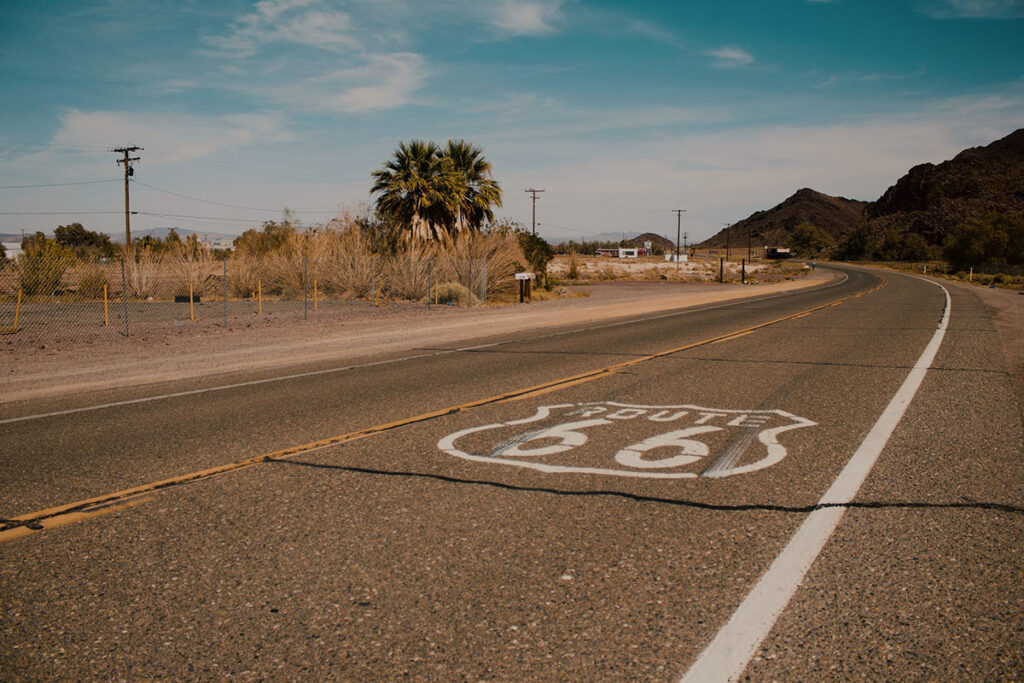
Established on November 11, 1926, Route 66, also known as the Mother Road, is one of the most famous highways in the United States. With over 250 bridges, buildings, and other sites listed on the National Register of Historic Places, the route embodies a rich and complex history that goes beyond the tales of the road itself.
In this article, I’ve listed some of the key places to visit on Route 66 during your road trip, as well as tips, tricks, and famous stops you shouldn’t miss!
Key Takeaways
- There are dozens, if not hundreds, of landmarks, locations, and landscapes along Route 66. Don’t rush; take the opportunity to bask in the scenic glory of the road.
- Though generally safe, Route 66 is subject to unexpected weather conditions. Always check the weather report before going out for the road and keep the weather news open on the radio to keep you updated.
- Plan your route in advance. Look through the major cities running through the Mother Road and spend some time drawing up an itinerary that reflects your travel preferences.
- Some of the best hiking spots in Route 66 Arizona include the Petrified Forest National Park (northeastern Arizona), Badger Trail (Kingman), and Lenox Crater Trail (Flagstaff).
What people say on Reddit
In general, I agree with the premise of avoiding chains, however, I urge you to make an exception for Blake’s Lotaburger in New Mexico. It’s a regional chain with a following not unlike In-N-Out in California, and well worth the stop.
Downhill_Marmot
Drive in movie if still showing in Springfield, ILL at the Route 66 drive in. My son’s favorite. Concur on side trips to things nearby. I would suggest take the interstate in one direction and get an idea of what you want to do on the way back. Maybe do the items you really want to do on the way out. Then on the way back you can linger, deviate, or if you run out of time just get back quickly. Barstow, CA has some cool stuff and going thru Amboy one that is cool, but staying on the I40 might be the more prudent thing to do.
whiskeyricky
Just take I40 to Williams, AZ. The last true real section of Route 66 in all its nostalgic glory. There’s a new mountain slide that is a riot along with plenty of memorabilia shops, restaurants and more. The Grand Canyon is 90 minutes away or overnight by train. Awesome area. We’ve got four grandkids nearby there and they love it.
jackrafter88
Do not miss the historic La Posada Hotel and Gardens – Fred Harvey’s “Last Great Railroad Hotel”, in Winslow AZ. We had one of the finest meals we’ve ever eaten at The Turquoise Room, which is inside the hotel.
SingleMother865
A Map of Route 66 Arizona Stops
Where does Route 66 start and end?
From east to west, Route 66 starts in Chicago, runs through Illinois and Missouri and continues west to Oklahoma, Texas, New Mexico, and Arizona en route to California.
Route 66 is around 2,450 miles long, though this can vary depending on the route you take. If you stick to the interstate without straying far from the road, the drive will be a bit shorter.
Why is Route 66 famous?
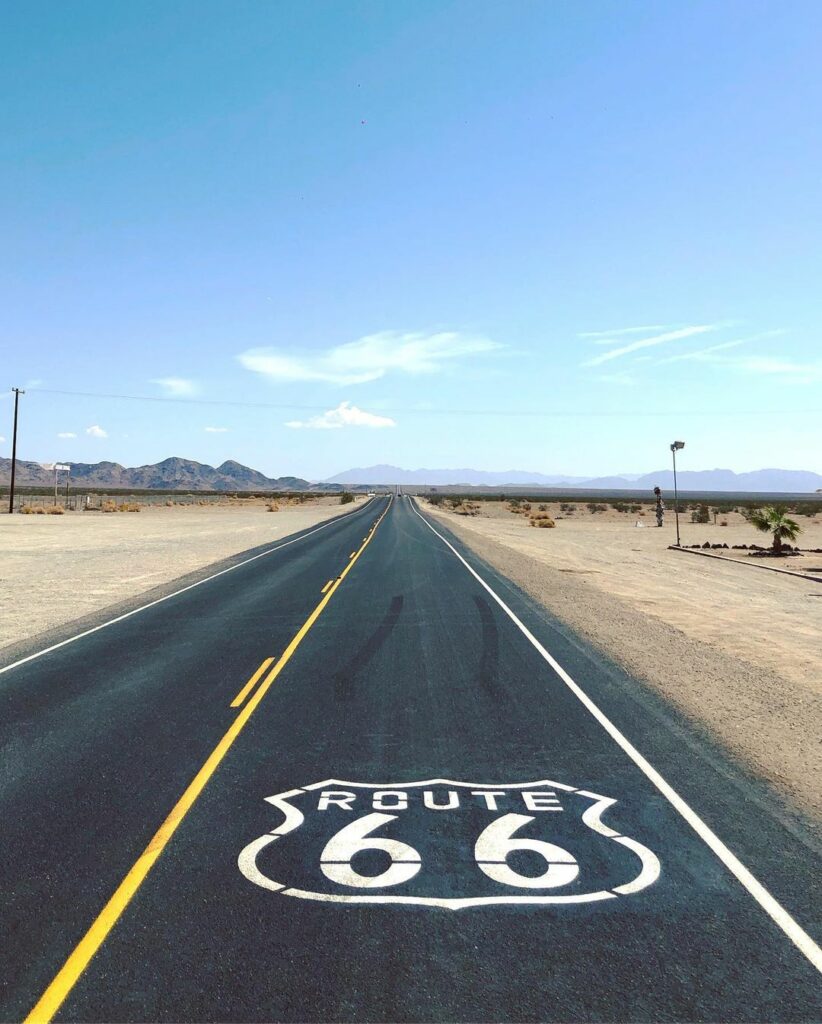
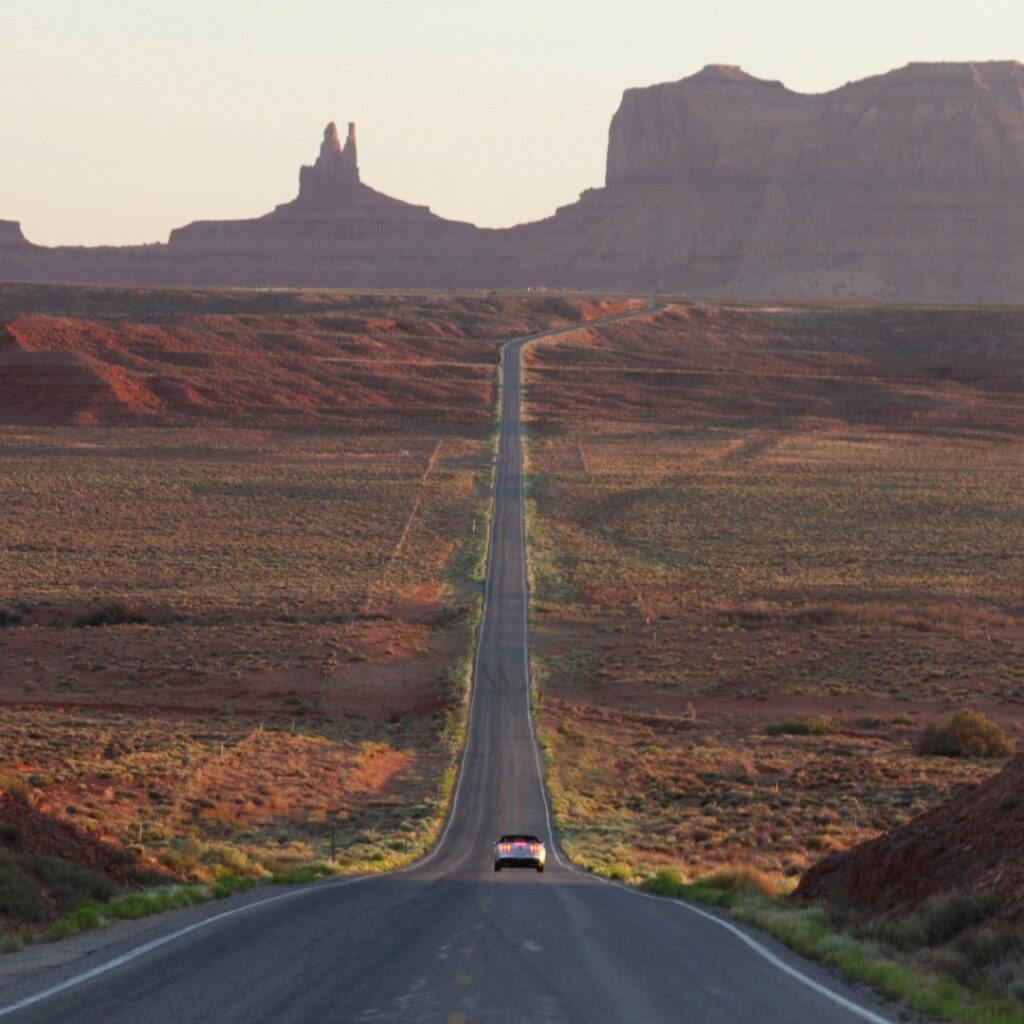
Believed to be the most scenic route from Chicago through Los Angeles, the Mother Road has long since symbolized freedom, mobility, and the pursuit of the American Dream. It’s the quintessential American road trip, ideal for those looking to make the drive a memorable part of the journey.
Road 66 has appeared in countless movies, TV shows, books, and art to showcase the evolution of the American road (Easy Rider, Bagdad Cafe, No Country for Old Men, Little Miss Sunshine, The Cars). It’s also used to paint the gorgeous stretches of deserted landscape people encounter during a road trip.
Road trips on Route 66 across Arizona – map, famous stops, and attractions
Route 66 boasts some of the most captivating drivable stretches of the old road, with miles upon miles of jaw-dropping scenery and famous attractions. From iconic landmarks to world-renowned museums, here are some of the key places to visit on Route 66!
Painted Desert and Petrified Forest National Park
Painted Desert is located about 50 miles from the New Mexico border in northeastern Arizona. It runs from the east end of Grand Canyon National Park and southeast into Petrified Forest National Park. It’s a vast, striated badland that stretches over 160 miles (260 km).
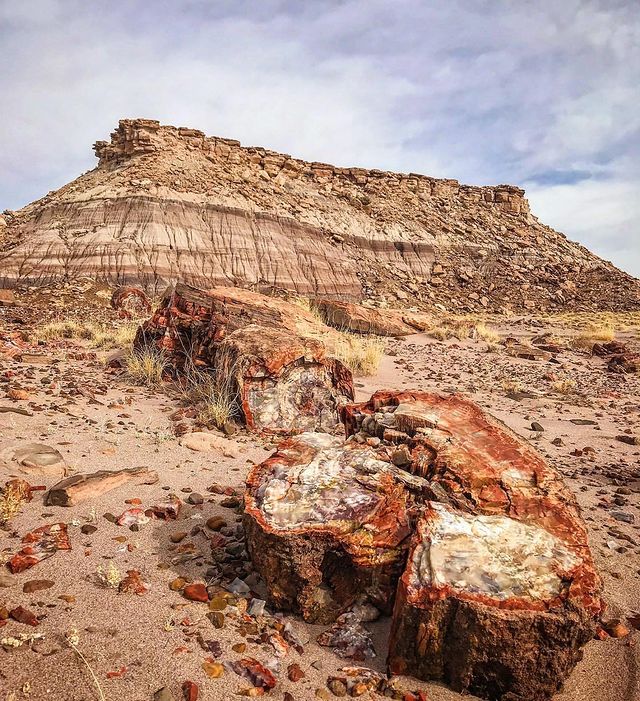
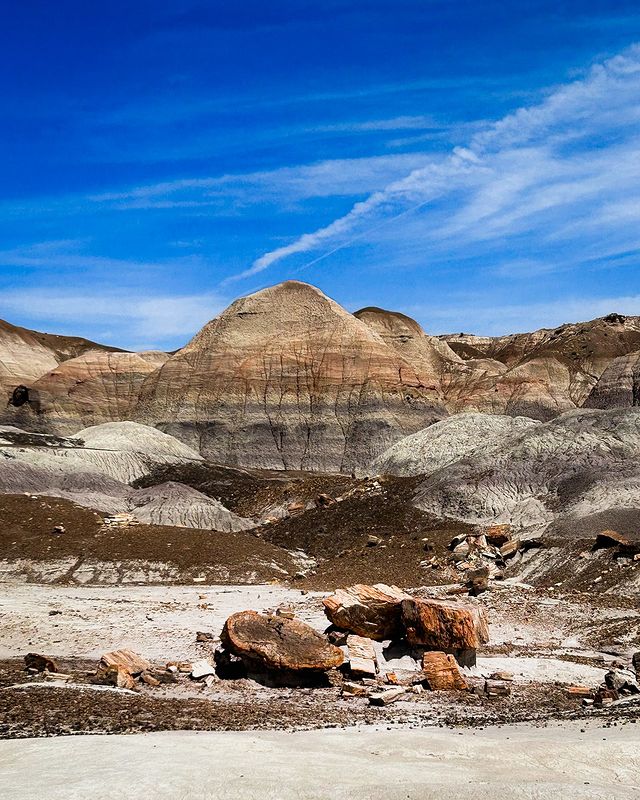
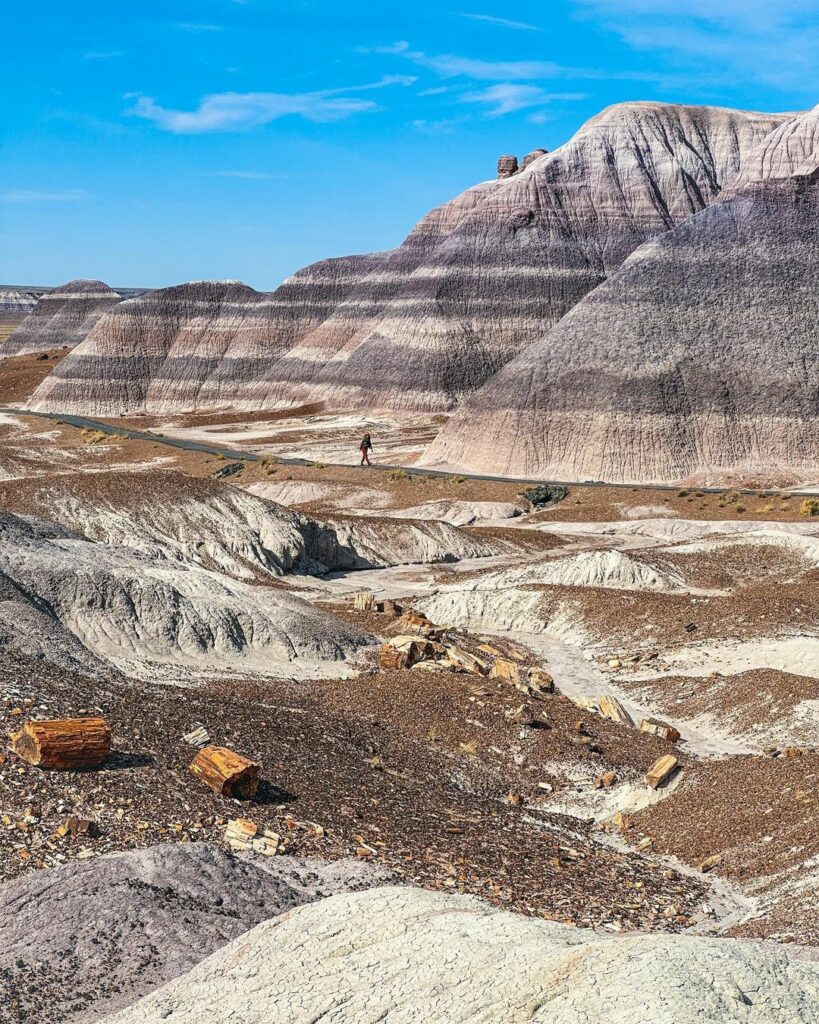
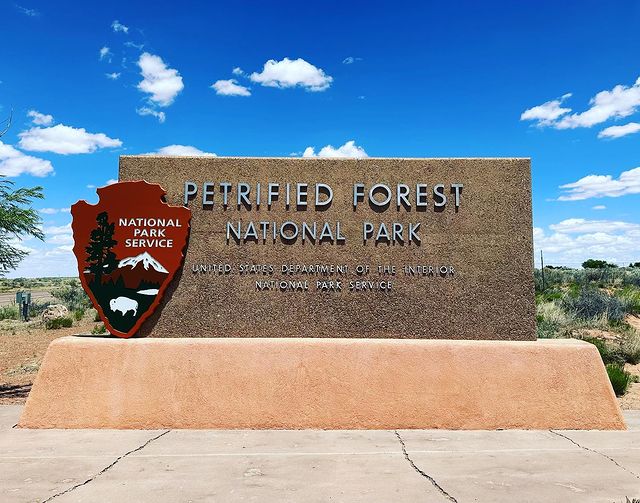
With picturesque hills emerging from a flat desert landscape, the Painted Desert is a prime example of weathering, erosion, and deposition in action.
As the sun rises above the horizon, you’ll be greeted with vivid colors of oxide red, ochre yellow, and burnt sienna contrasting with faint lavenders, putting even the most photo-realistic paintings to shame. Such geological wonder can only be appreciated in real-time, so make sure to stop and soak in the views when passing by!
The Petrified Forest National Park is part of the Painted Desert. Though mostly known for its large deposits of petrified wood, the 346-square mile (900 sq. km) park is more than just an archeological hub. Though mostly desolate, closer inspection reveals an ongoing 200-million-year-old geological experiment that not many are lucky to witness.
As you drive through the surreal landscape, you’ll find yourself surrounded by wide ravines, blue-striped badlands, and miles upon miles of petrified tree skeletons and wooden houses.
Meteor Crater
As you drive south of Route 66, you’ll encounter the Barringer Crater, also known as the Meteor Crater.
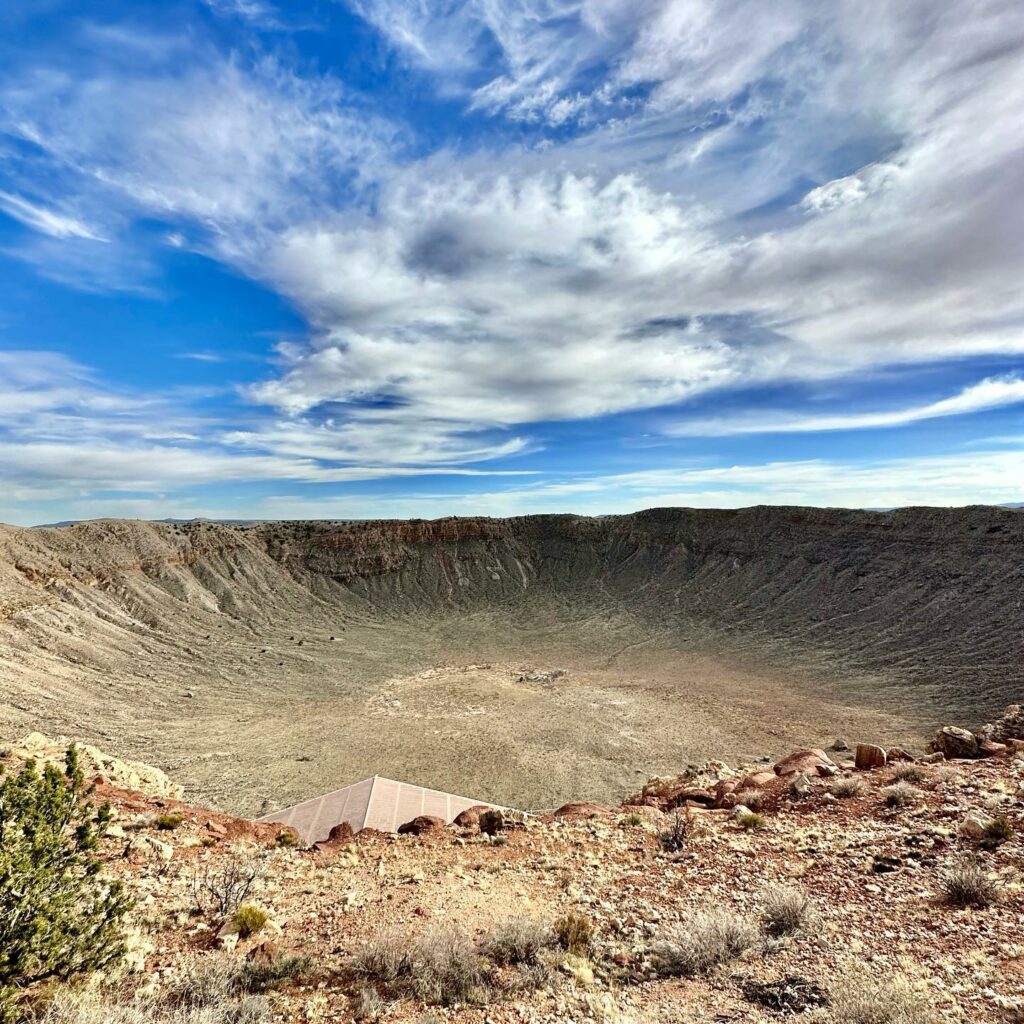
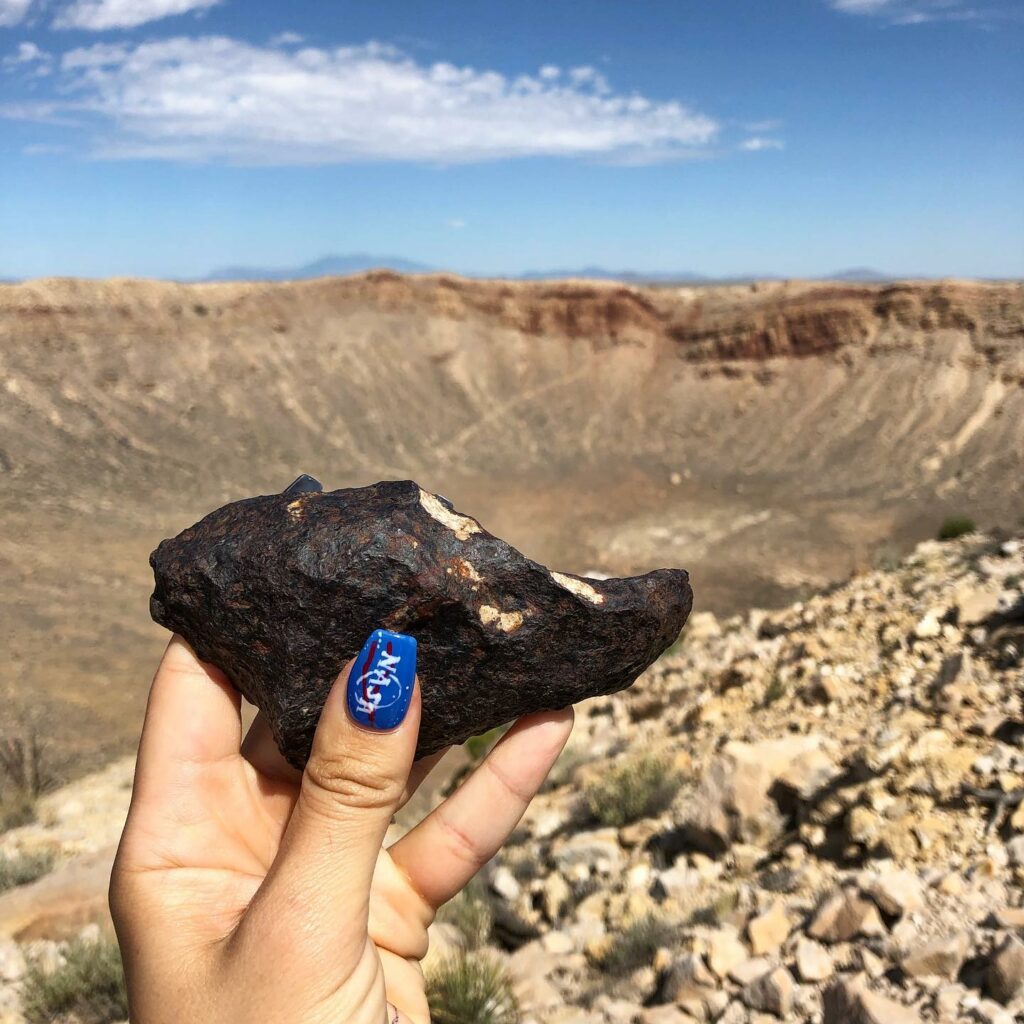
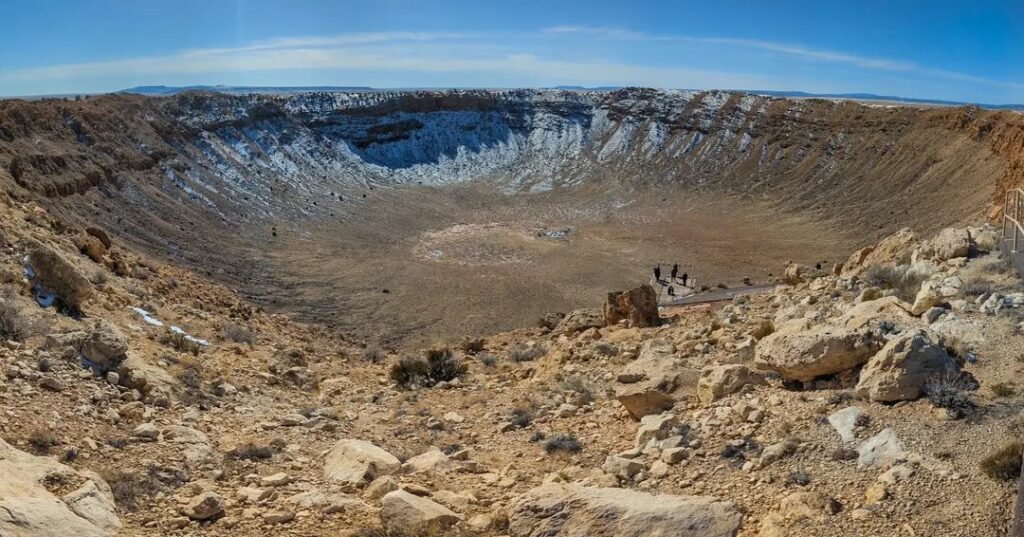
Believed to have formed over 50,000 years ago, the Barringer Crater—named in honor of the geologist Daniel Barringer—is the first proven meteorite crater on Earth. It’s nearly one mile (1.6 km) across, 2.4 miles (3.8 km) in circumference, and over 550 feet (167 m) deep. To put the size into perspective, that’s nearly the size of 20 football fields combined together.
As one of the world’s most preserved meteor craters, descending within it is strictly prohibited. However, you’re free to take pictures and visit its numerous exhibitions and exhibits. It’s a real treat for aspiring geologists, meteorologists, and space fans alike.
Entrance fees range from $18 to $24, but discounts are available for large families.
Walnut Canyon National Monument
The Walnut Canyon National Monument is a 30-minute drive from the Meteor Crater. It’s located roughly 10 miles (16 km) southeast of downtown Flagstaff.
Known for its remarkable rock formations and ancient cliff dwellings, the Walnut Canyon National Monument is a one-of-a-kind historic landmark that tells the story of ancient inhabitants.
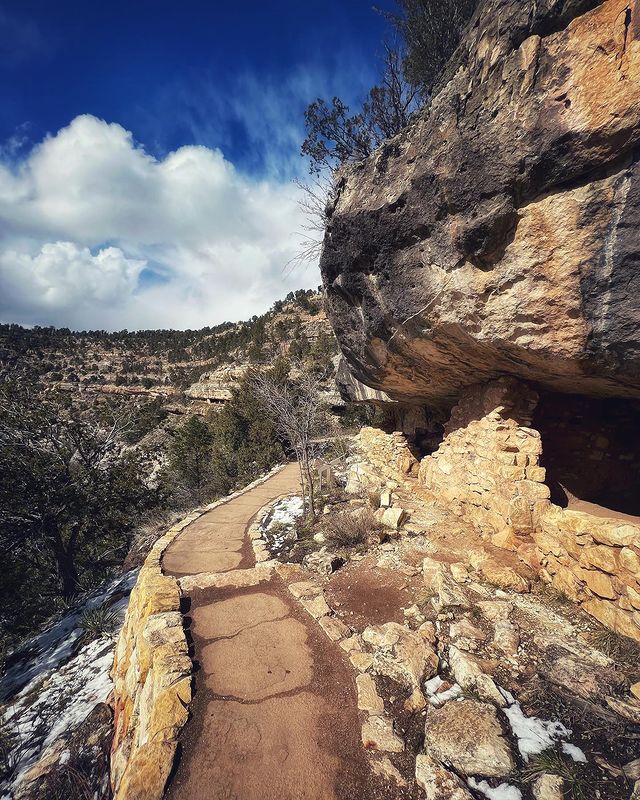
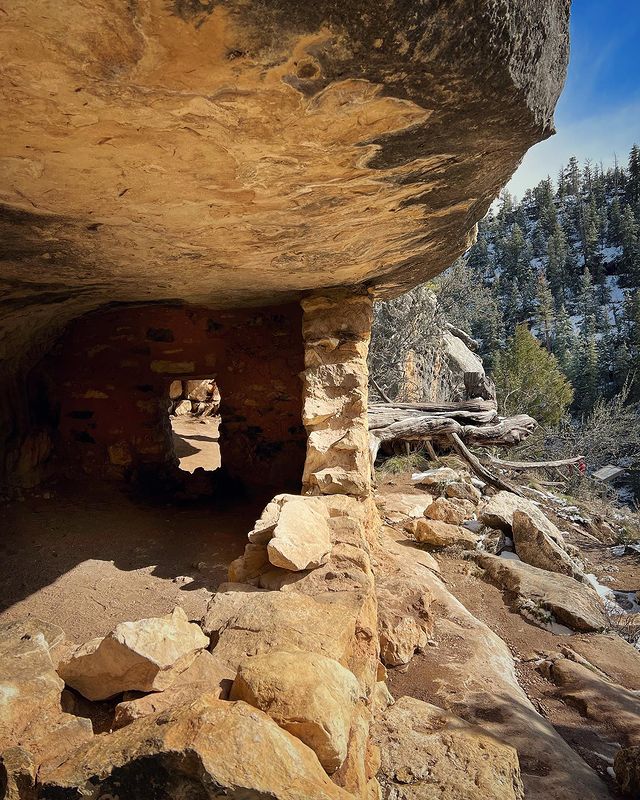
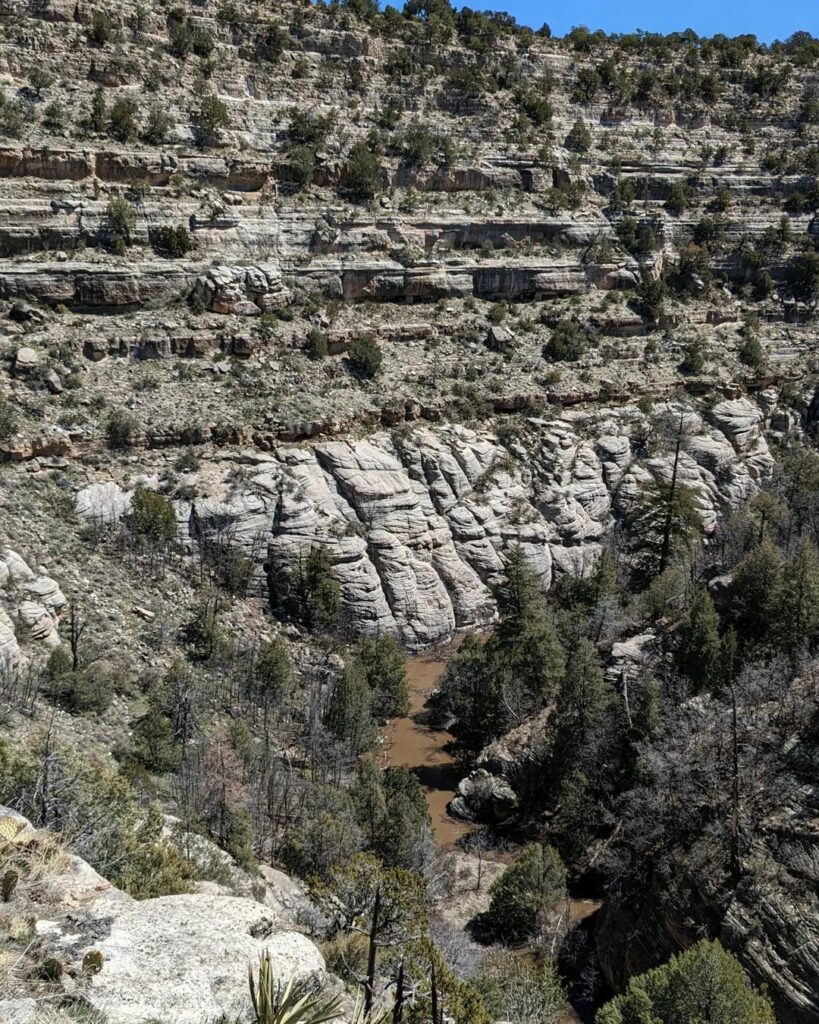
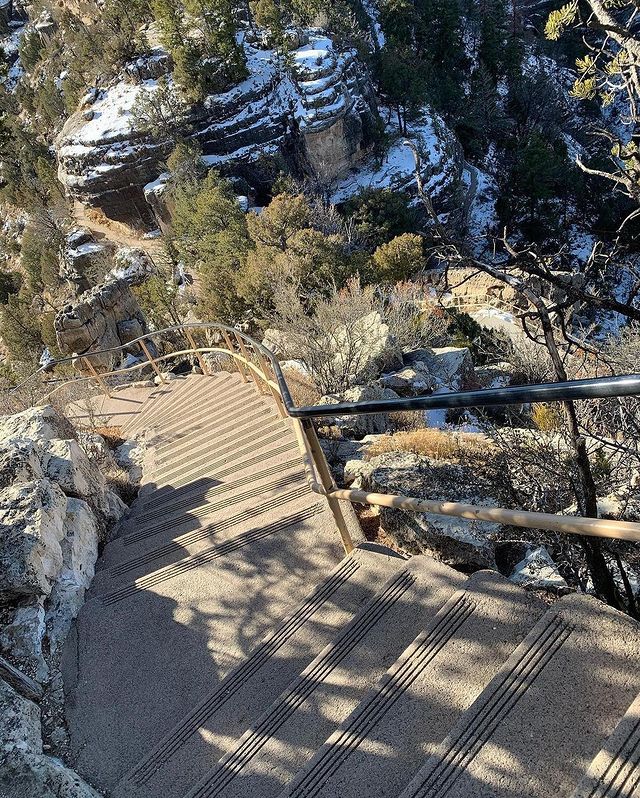
Along the trails, it’s easy to imagine the bygone days of a distant past. The above-ground cliff dwellings of the Sinagua built between 1125 and 1250 CE (Common Era), are shockingly intact, appearing as though they were built by modern architects. The dwellings overlook Walnut Creek, a vibrant city that sits at the base of Mt. Diablo.
Apart from the cliff dwellings, you can enter the Walnut Canyon Visitor Center and envision what life was like back in the day through its many exhibits and murals. The exhibitions include artifacts and ancient materials collected at the site, such as clay pitches and cloth made of cotton and yucca fibers.
You can also visit the pithouses and freestanding pueblos scattered on the rim of the canyon, or simply bask in the scenic views the national monument has to offer
Sunset Crater
The Sunset Crater, also known as the Sunset Volcano, is a volcanic crater located about 15 miles (25 km) northeast of Flagstaff, Arizona, and 80 miles from the Grand Canyon along the historic Route 66. It’s the youngest volcano of the Colorado Plateau, named for its multi-hued, red-spattered cone that makes it look as though it’s bathed in the light of the sunset.
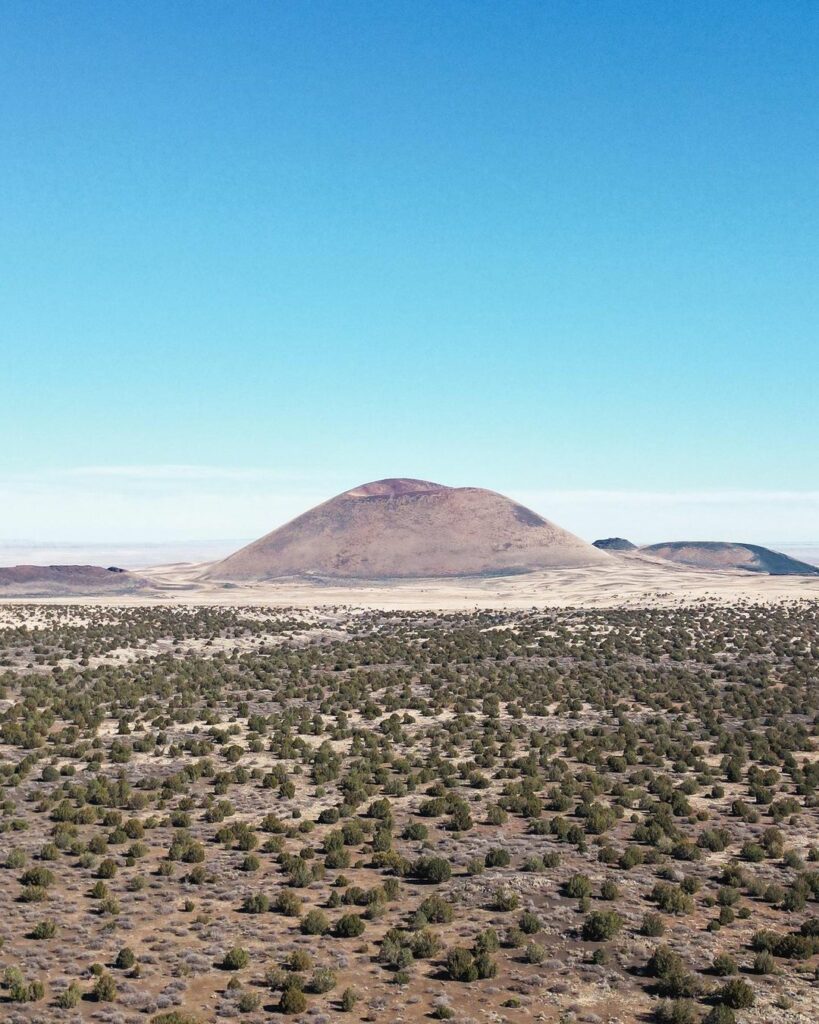
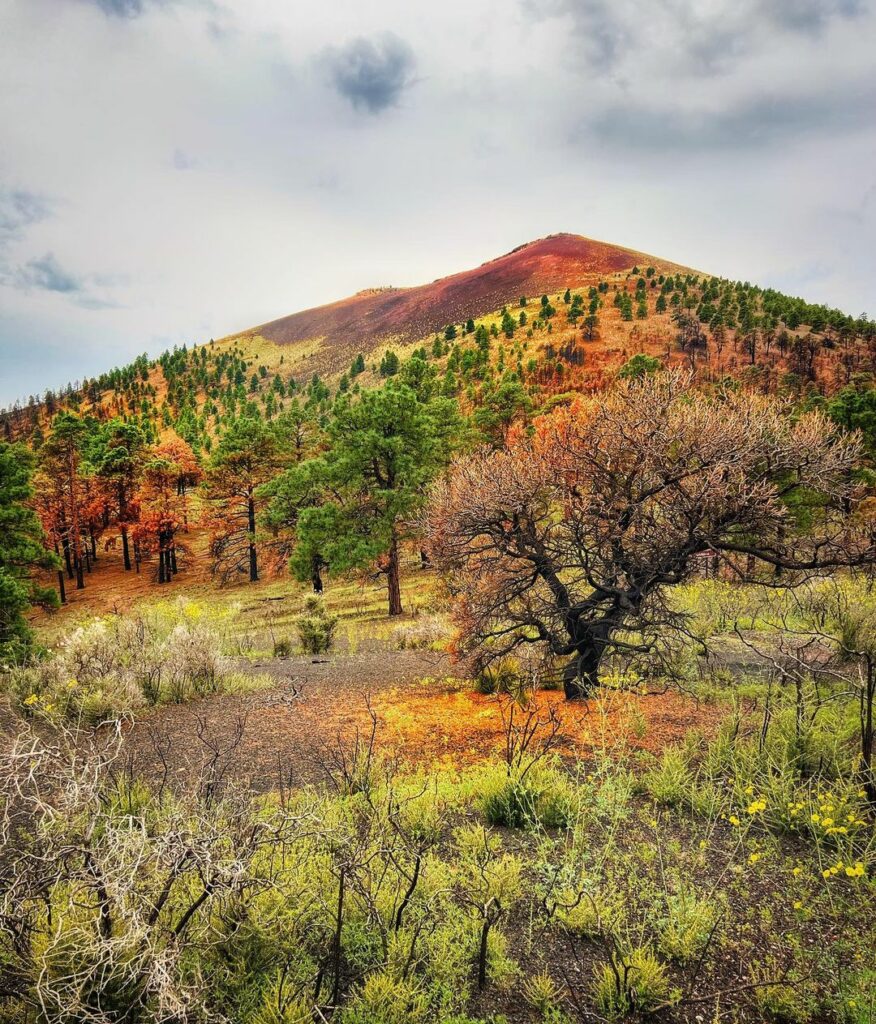
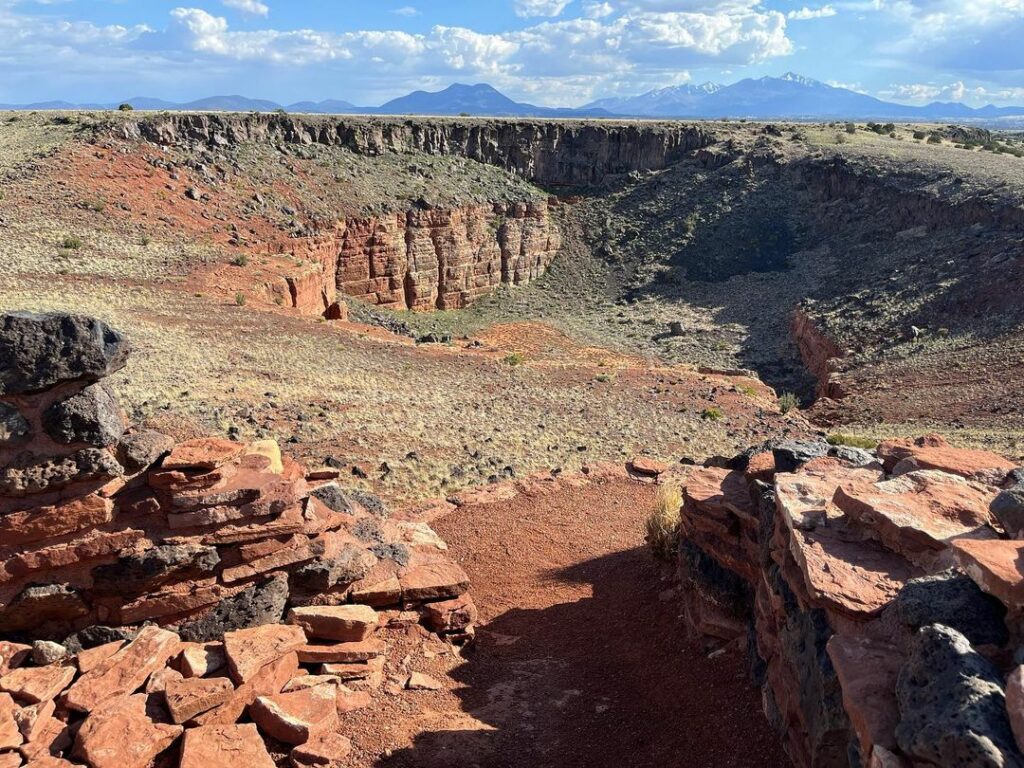
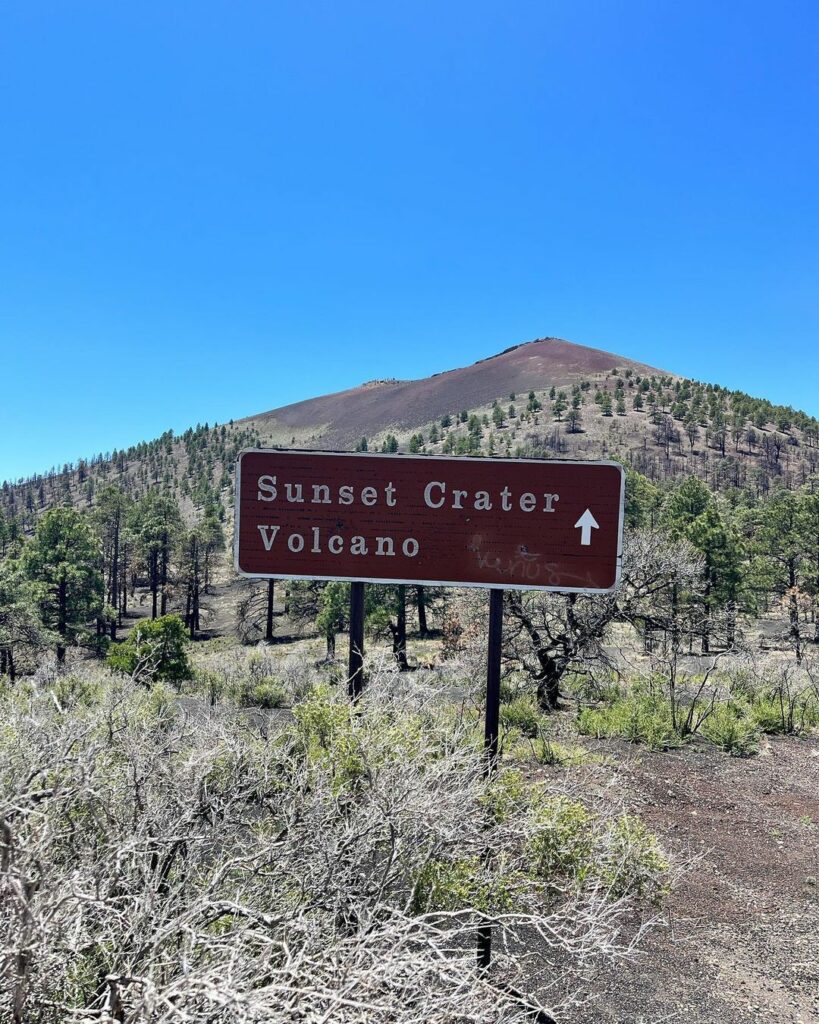
The Sunset Crater erupted some 900 years ago around A.D. 1085. The exact reason for its eruption is still unknown, despite the efforts of dozens of scientists.
Luckily for us, the volcano is dormant. This means that visitors are free to explore the Bonito Lava Flow and hike the trails surrounding the volcano.
At around 3,000 acres, the Sunset Crater National Volcanic Monument is small compared to others in the area. The Loop Road gives you access to the whole area and continues to Wupatki National Monument, a Native American archaeological site.
The trail to the top of the Sunset Crater is unfortunately closed due to the deep ruts and erosion left by the feet of thousands of hikers in the past. By taking the Lenox Crater Trail or the Forest Service Trail, you can climb to the top of another cinder cone and look down into the Sunset Crater.
Flagstaff
Route 66 runs directly through Flagstaff, an energetic town standing on the Colorado Plateau.
Unlike the other historic sites of Route 66 affected by the demise of the old road, Flagstaff is surrounded by high mountain wilderness. Within it lies a city of nearly 150,000 friendly residents that take pride in the area’s past.
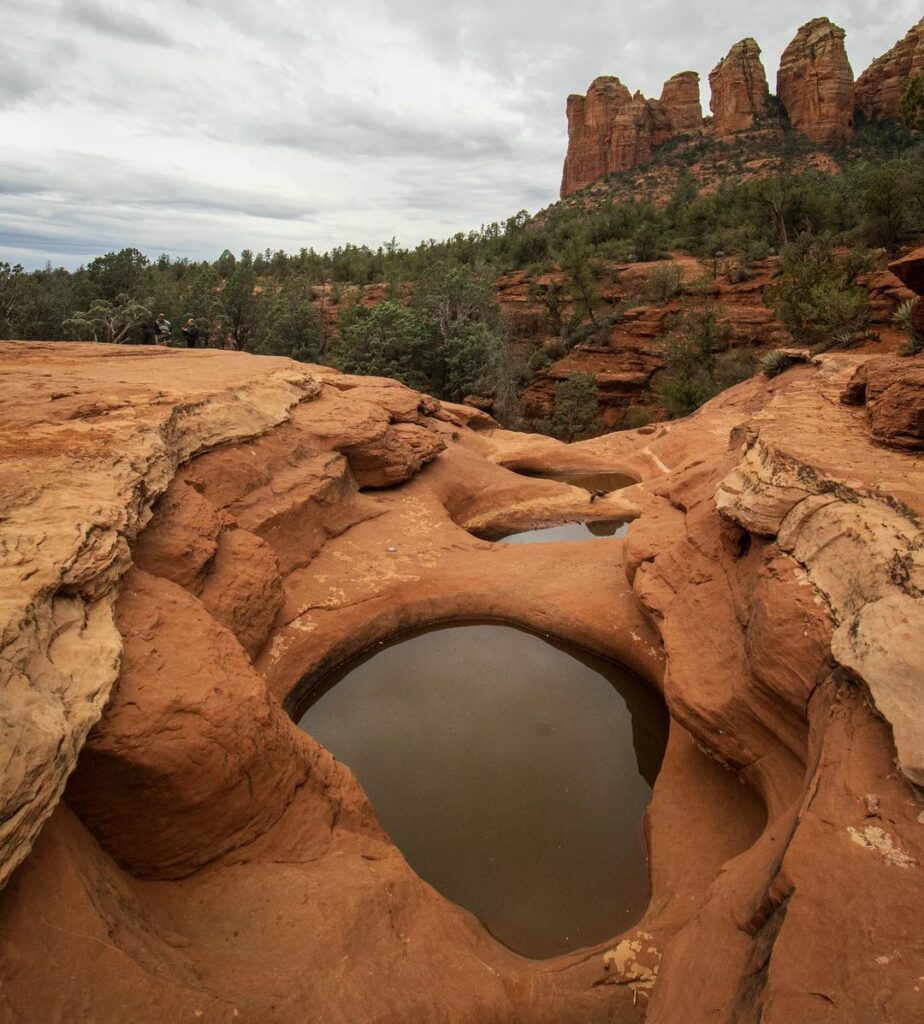
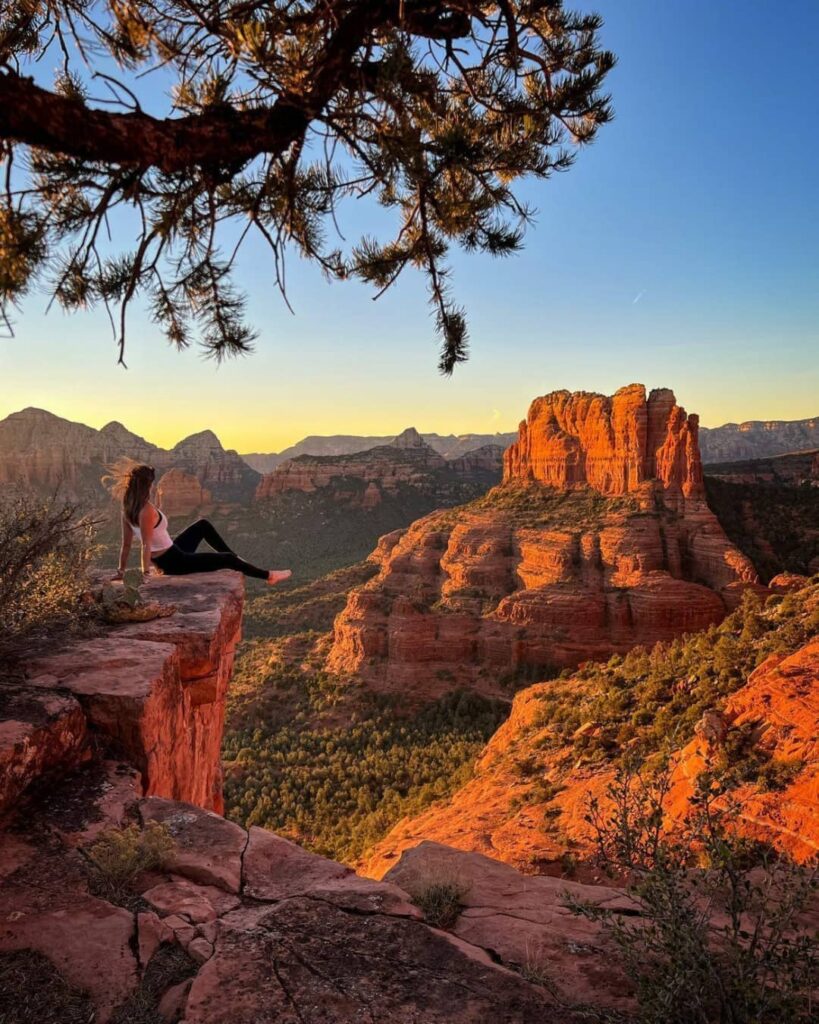
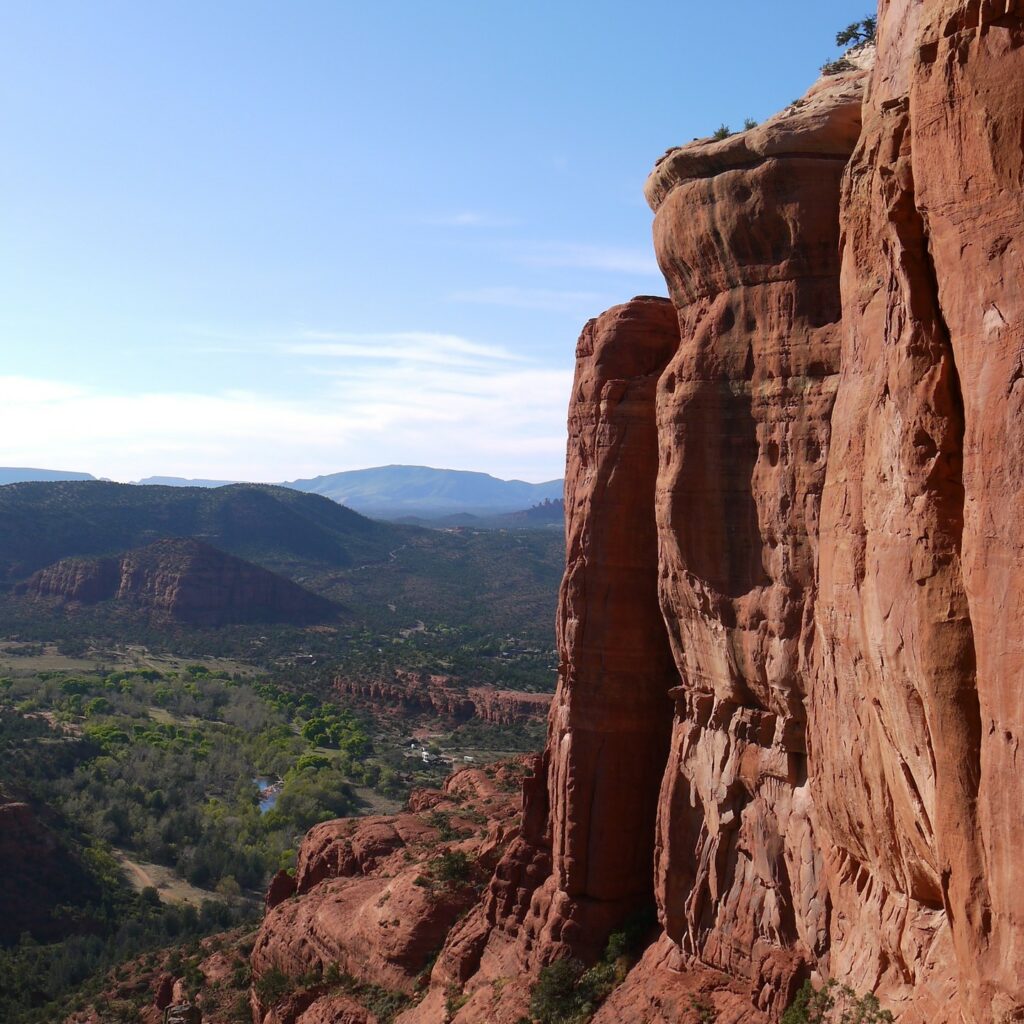
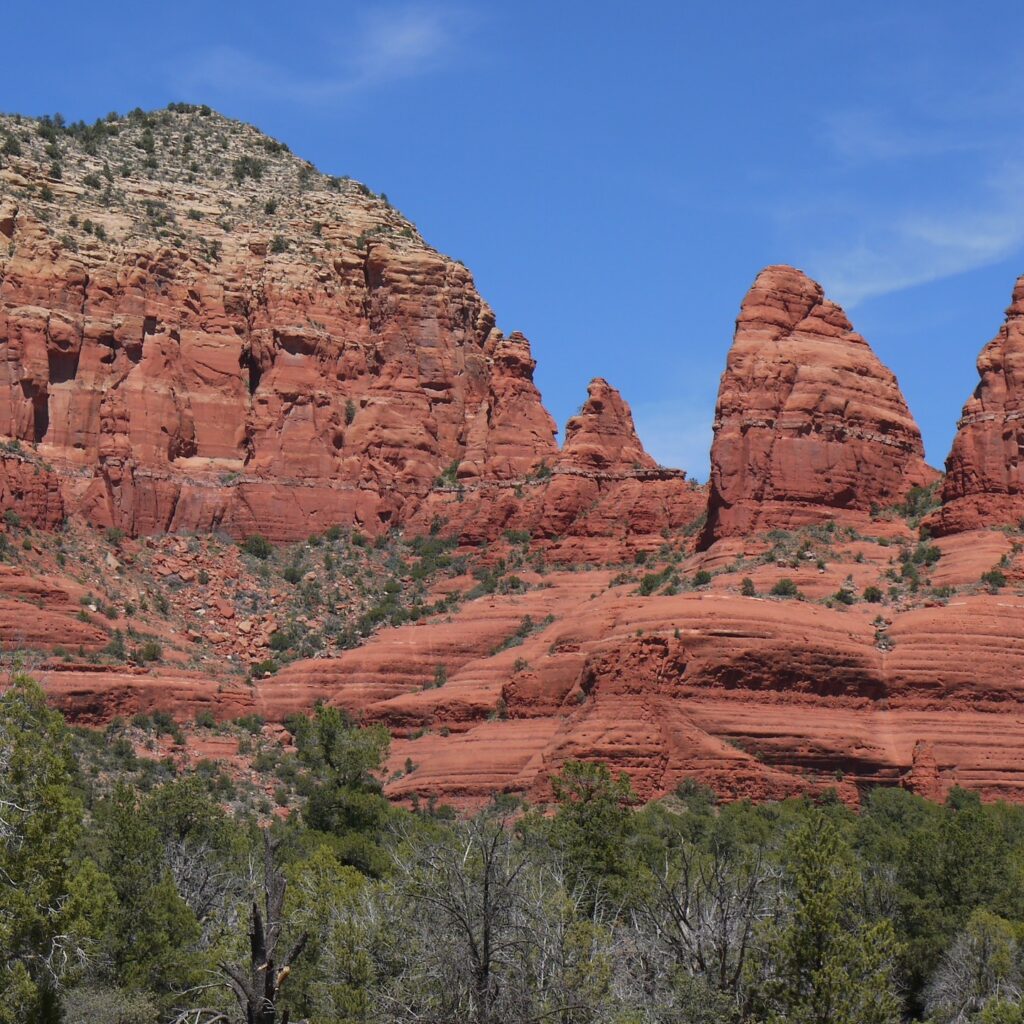
Flagstaff offers dozens of must-see spots, such as the Mix Zips, the Museum Club, and the Flagstaff Visitor Center. If you want to unwind from your travels, downtown Flagstaff has more than enough espresso bars to satisfy its many visitors.
You’ll also find dozens of ethnic restaurants specializing in German, Thai, Greek, or Indian cuisine, so you won’t find any trouble locating suitable places to eat and drink.
Flagstaff’s hiking trails draw in hikers from across the globe due to their incredible views. The city is completely surrounded by the Coconino National Forest, housing more than 90 trails with the most popular being West Fork Trail, Boynton Canyon Trail, Courthouse Butte Loop, and Devil’s Bridge.
Anglers can fish at West Clear Creek, Verde River, and the C.C. Cragin (Blue Ridge) Reservoir to catch pike, catfish, and similar fish.
Williams
Known as the Gateway to the Grand Canyon, Williams, Arizona of Route 66 is a town full of character, charm, and unique signs. Though home to only around 3,000 permanent residents, it offers a surprising amount of things to do.
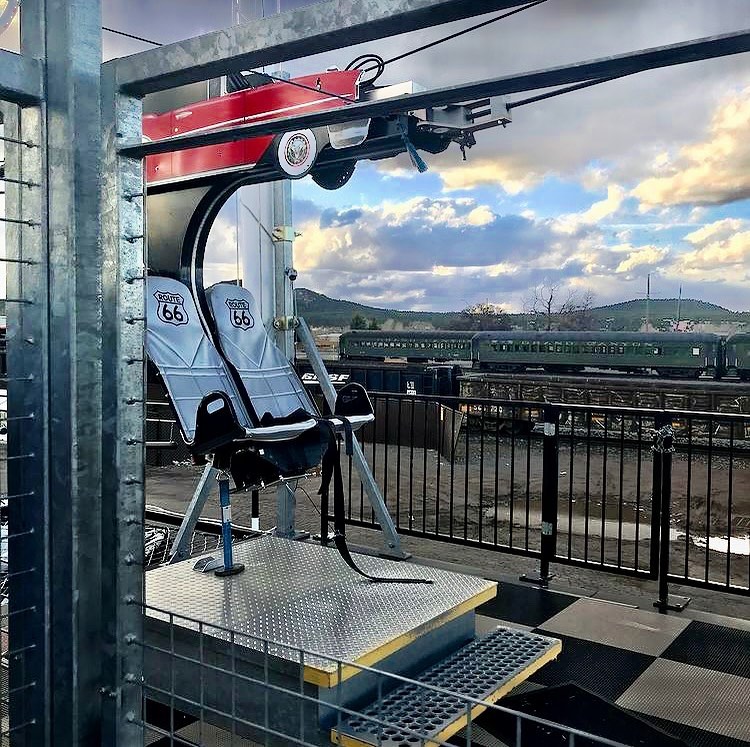
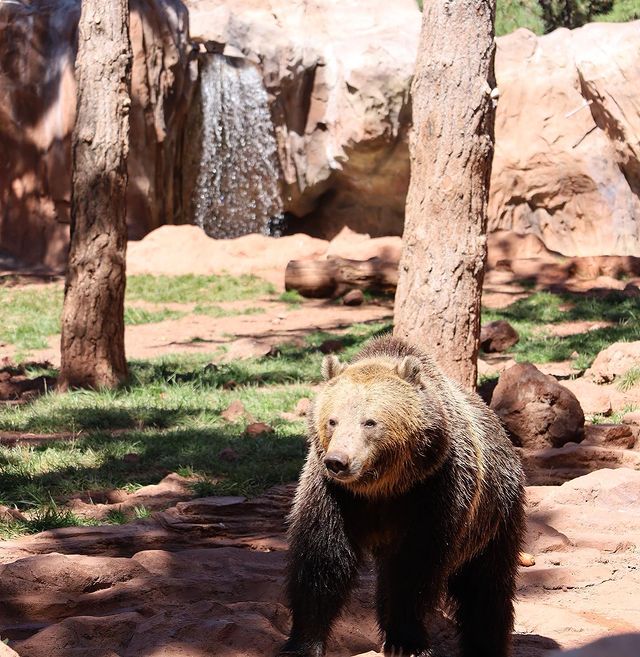
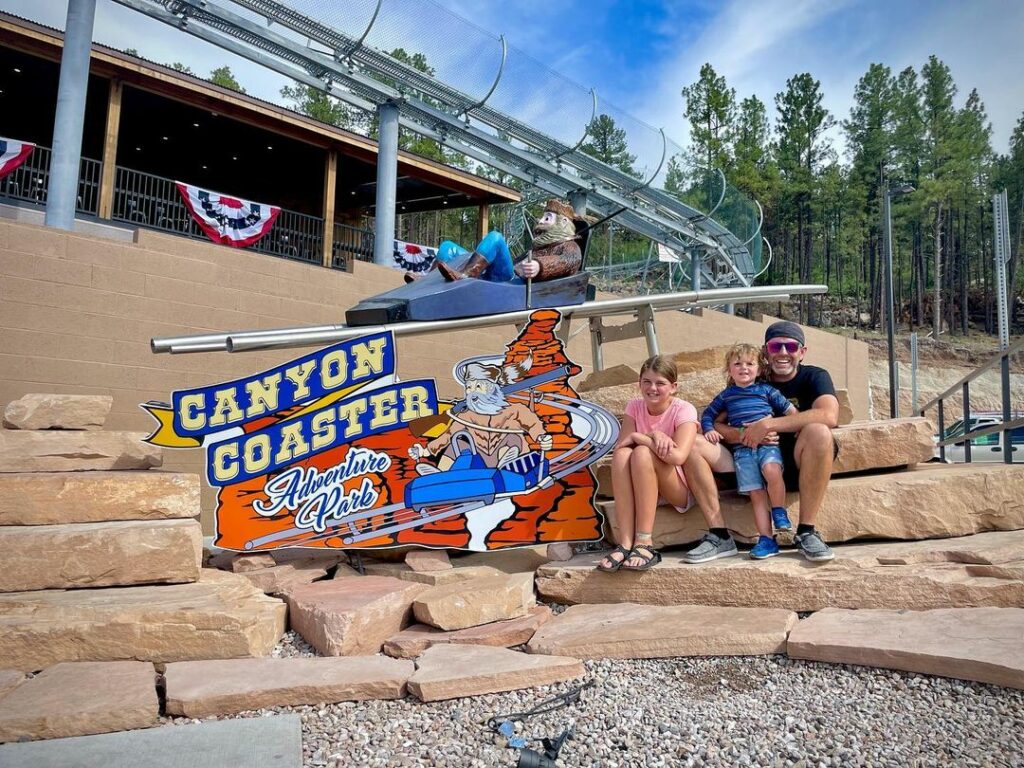
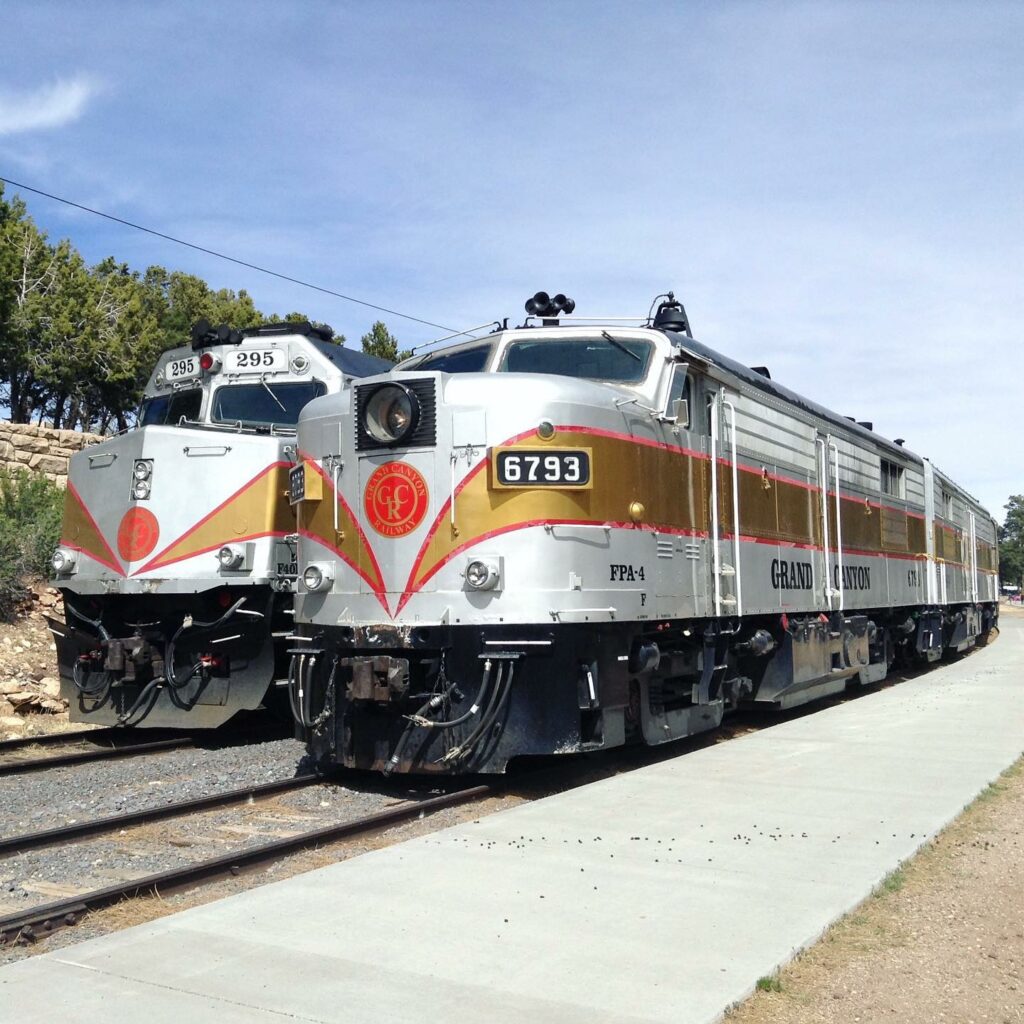
For first-time visitors, the Williams Visitor Center is a must-visit to get a lay of the land and uncover the hidden gems of Williams. Well-informed staff will educate you on everything Williams-related, from its history to the town’s best and most well-known establishments and attractions.
After the tour, you can hop aboard a train at the Grand Canyon Railway Depot to get a taste of the old West railroad or learn more about the town’s history at the Welcome and History Park.
If you’re more of a thrill-seeker, book a seat at the Route 66 Zipline. The zipline suspends you 110 feet (33.5 m) off the ground and runs for 1,400 feet (427 m), providing you with stunning views of Grand Canyon Boulevard.
Other popular attractions in Williams include the Bearizona Wildlife Park and the Grand Canyon Deer Farm—perfect for wildlife enthusiasts—and the Canyon Coaster Adventure Park and Grand Canyon Go-Karts to let loose and have fun.
Sedona and Jerome
The drive from Sedona to Jerome and vice versa takes approximately 45 minutes, allowing you to visit both neighborhoods within a day or two and have plenty of time to spare.
Sedona is one of Route 66’s most popular vacation destinations and a hot spot for New Agey visitors, who frequent the desert town for psychic channeling, astral travel, and the like.

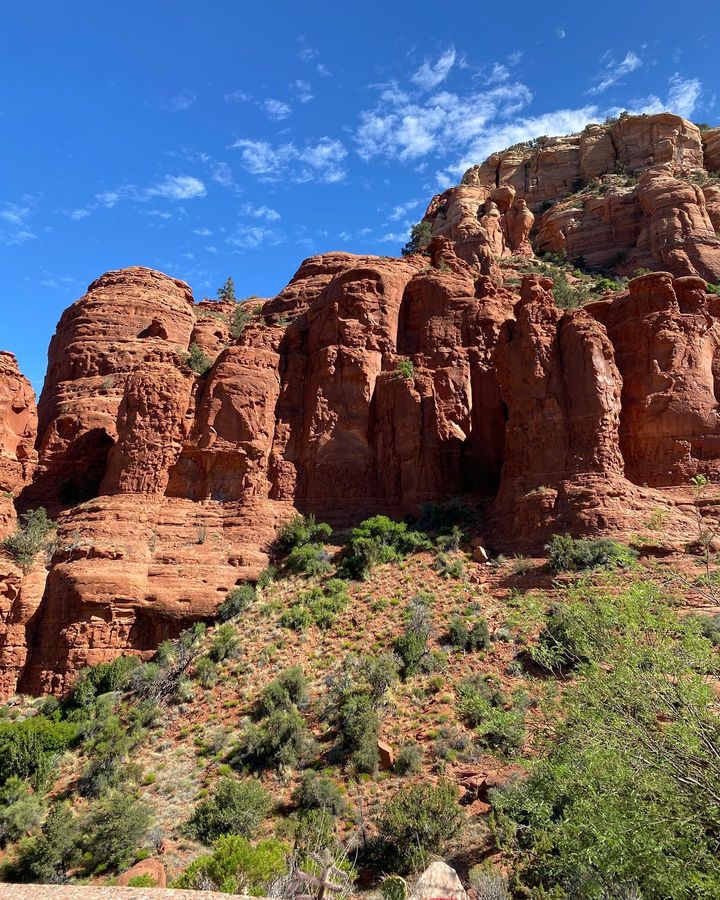
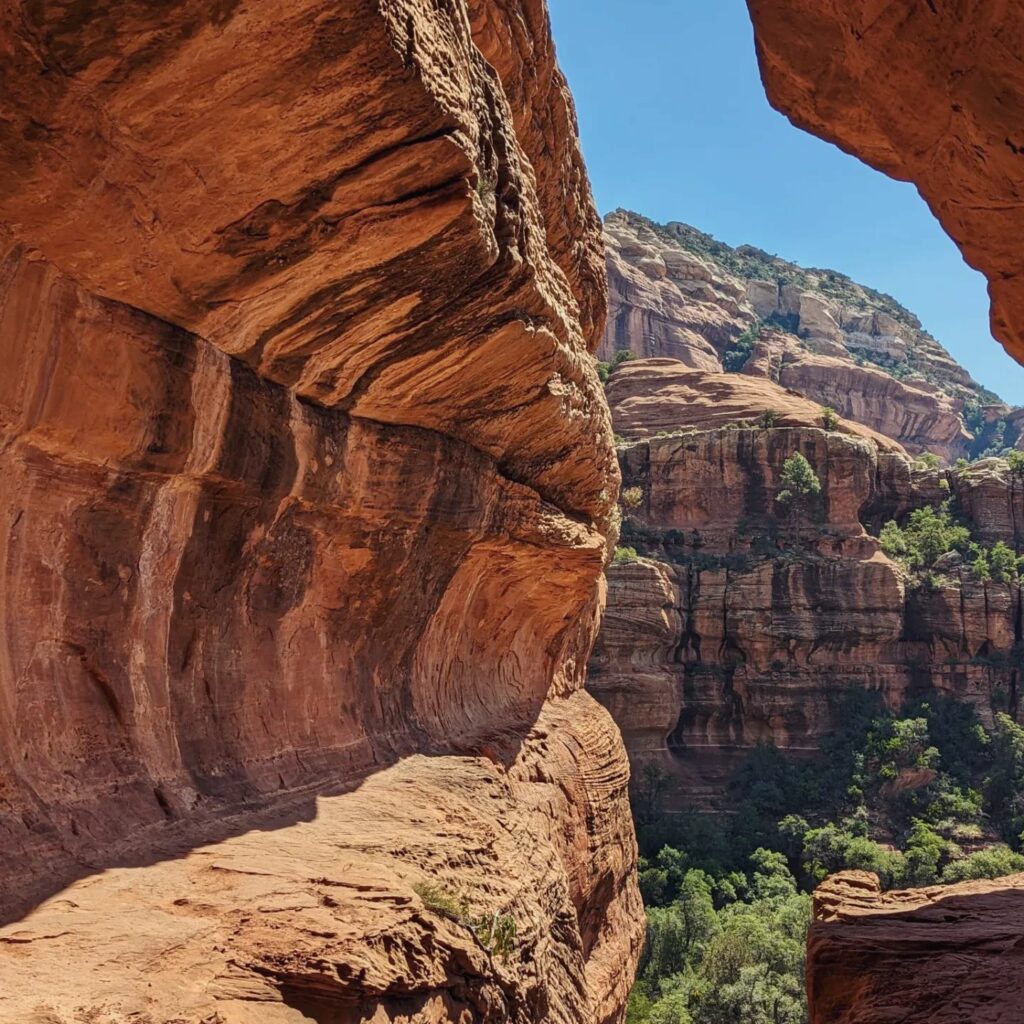
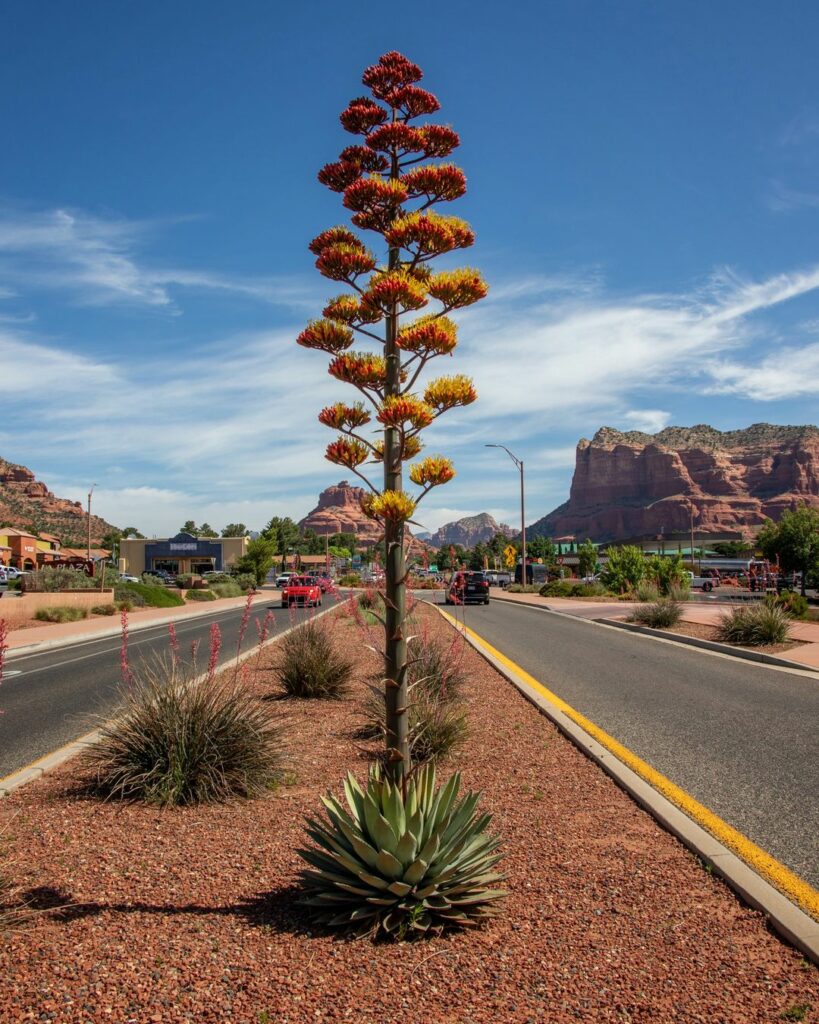
In Sedona, you can explore hidden caves, hike through canyons, and climb up some of the highest mountain peaks. If you visit during the summer, don’t miss the opportunity to go for a swim in one of the many lakes and rivers in Oak Creek Canyon.
South of Route 66, you’ll come across the desert town of Jerome. Once dubbed “The Wickedest Town in the West,” Jerome is now considered the largest ghost town in America with less than 500 permanent residents. Strolling through the town feels much like being transported back in time, surrounding you with dozens of historical sites, buildings, and museums.
Seligman
Seligman, AKA the Birthplace of Historic Route 66, is a favorite stopping place on Mother Road. It’s chock-full of retro shops, motels, and diners, making it an excellent destination to rest up.
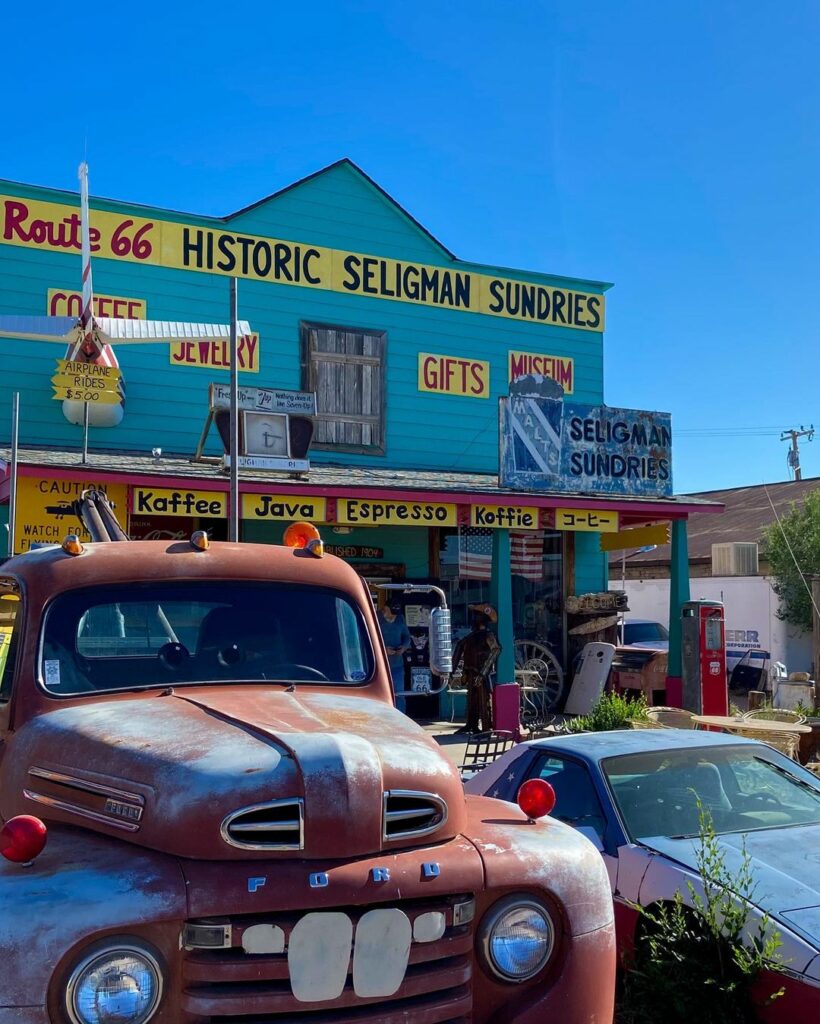
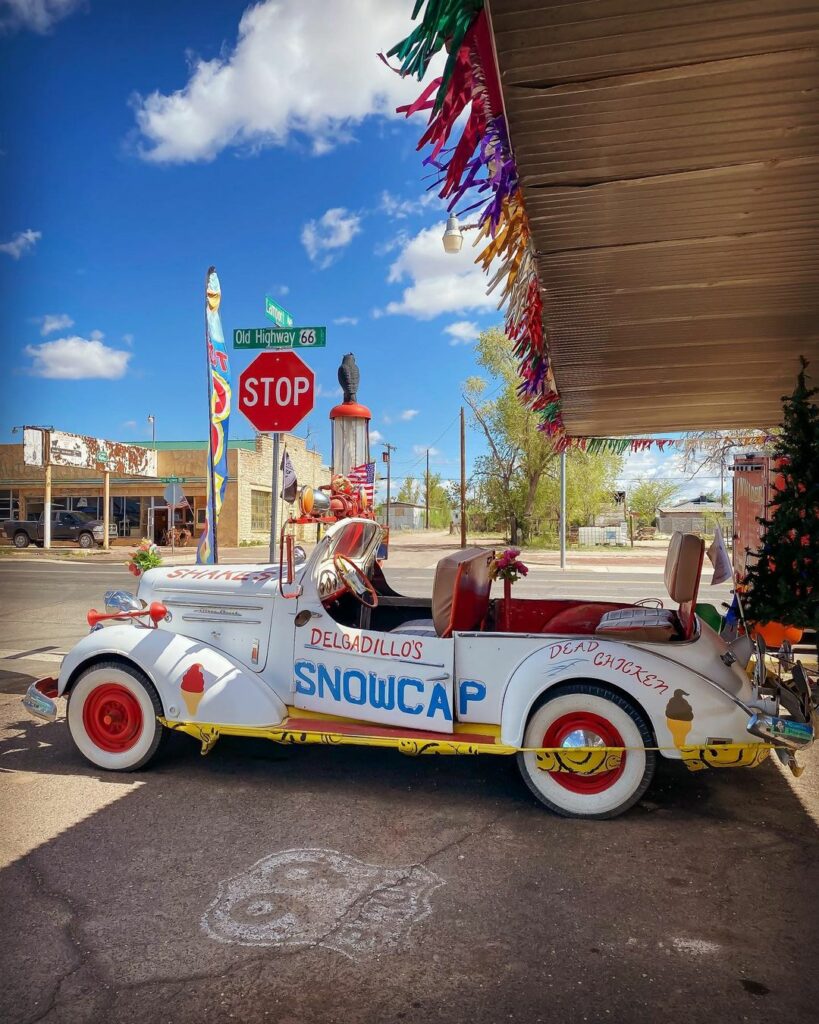
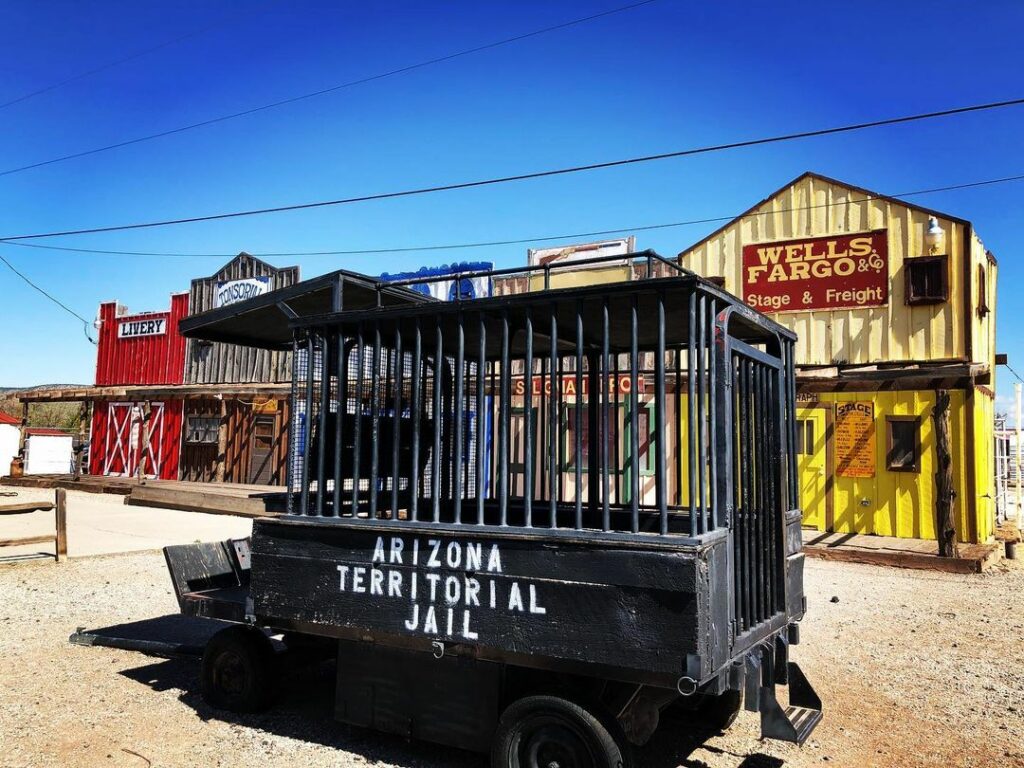
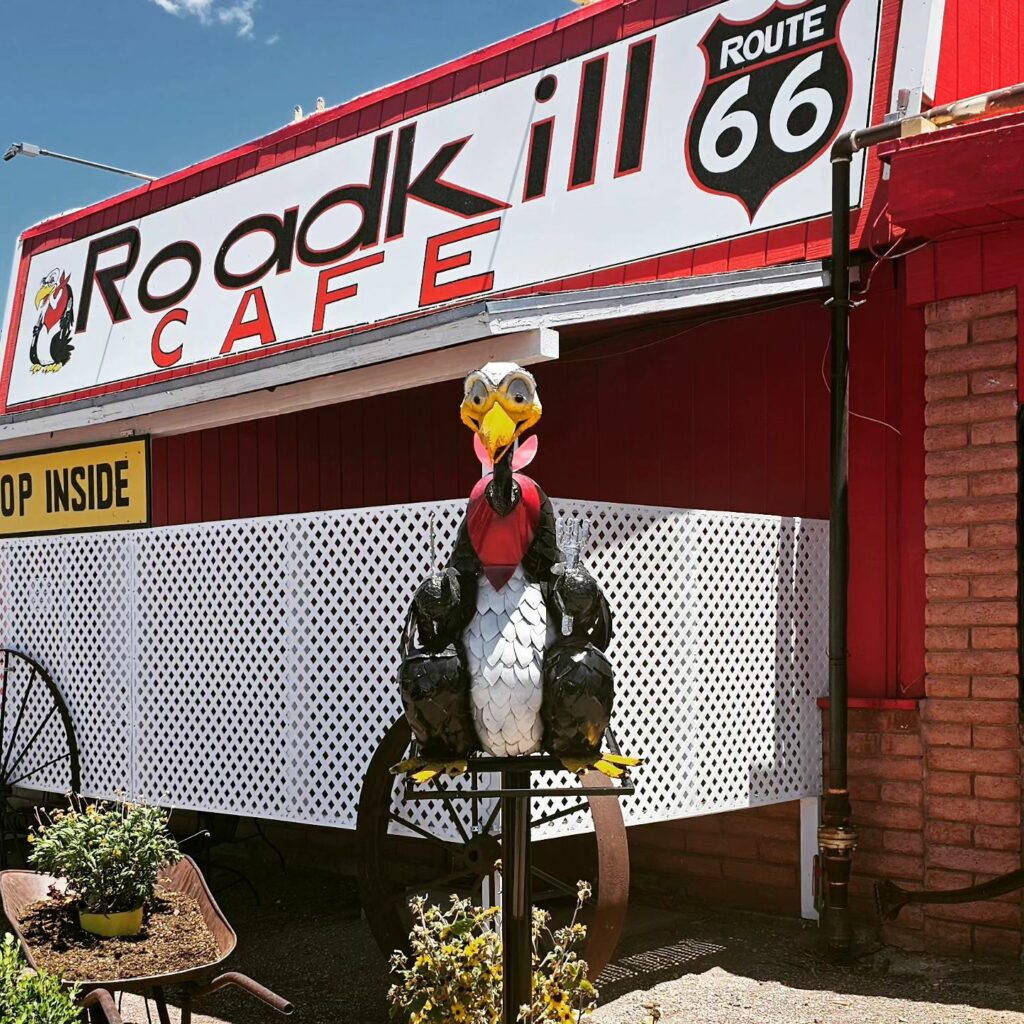
Among many of Seligman’s tourist attractions is a gas station-converted museum known as the Return to the 50s Museum. Upon entering, you’ll be met with vintage motorcycles, cars, and other Route 66 and 1950s memorabilia. You’ll even see Tow Mater and other characters from the Pixar animated movie Cars, which, fun fact: is entirely based on the town of Seligman!
You can also visit specialty gift shops, check out the Motoporium, and see the inside of the historical 1860 Arizona Territorial Jail.
At the end of the trip, stop by the famous Roadkill Cafe and try out one of their many specials: Bad-Brake Steak, Deer Delectables, Splatter Platter, Caddie Grilled Patty, and Swirl of Squirrel, among many others.
Grand Canyon Caverns
At the Grand Canyon Caverns, you get to feast your eyes on the incredible natural wonder that began 345 million years ago.
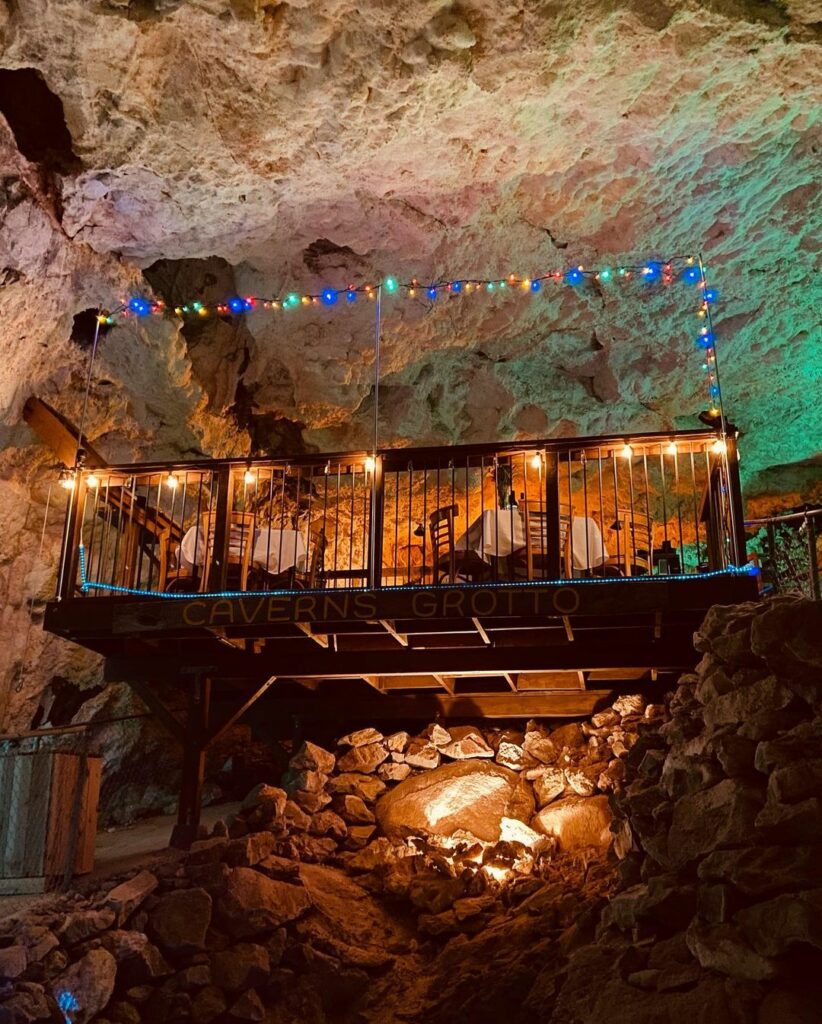
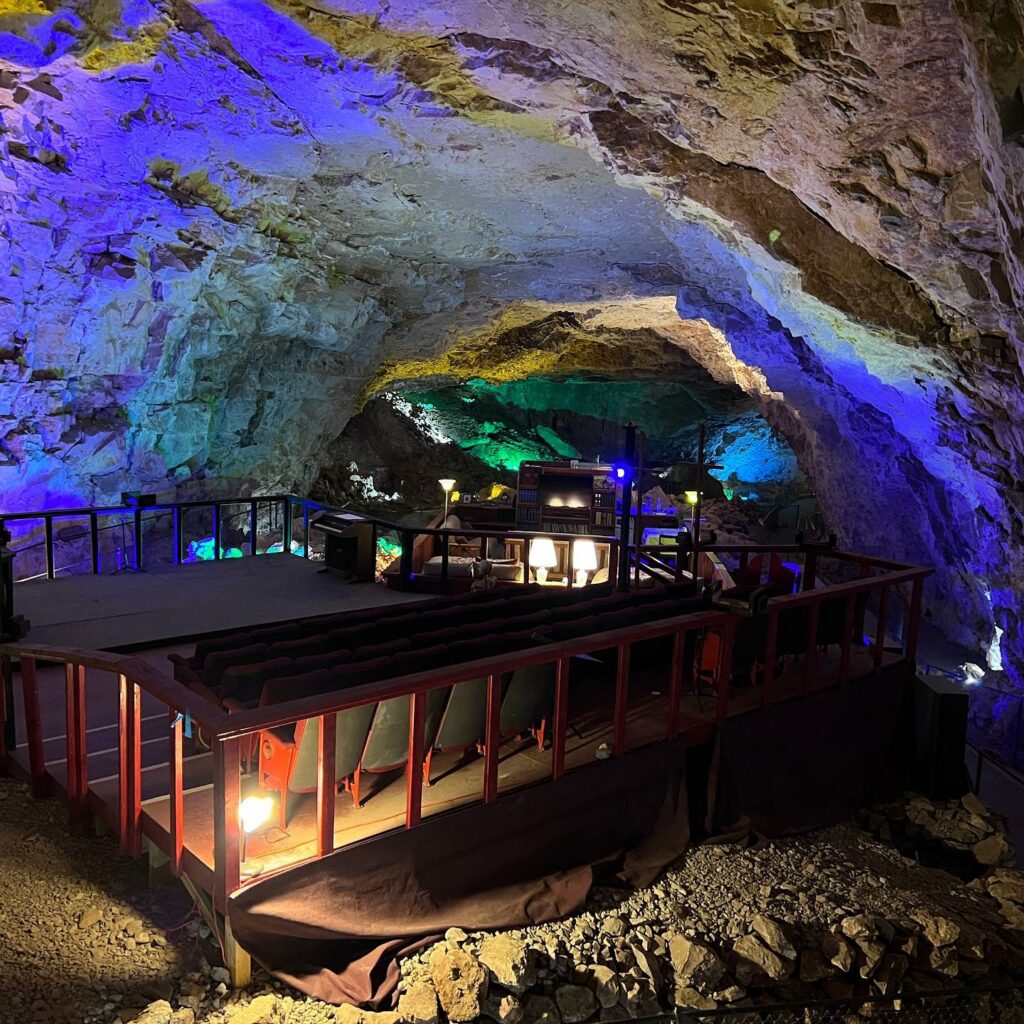
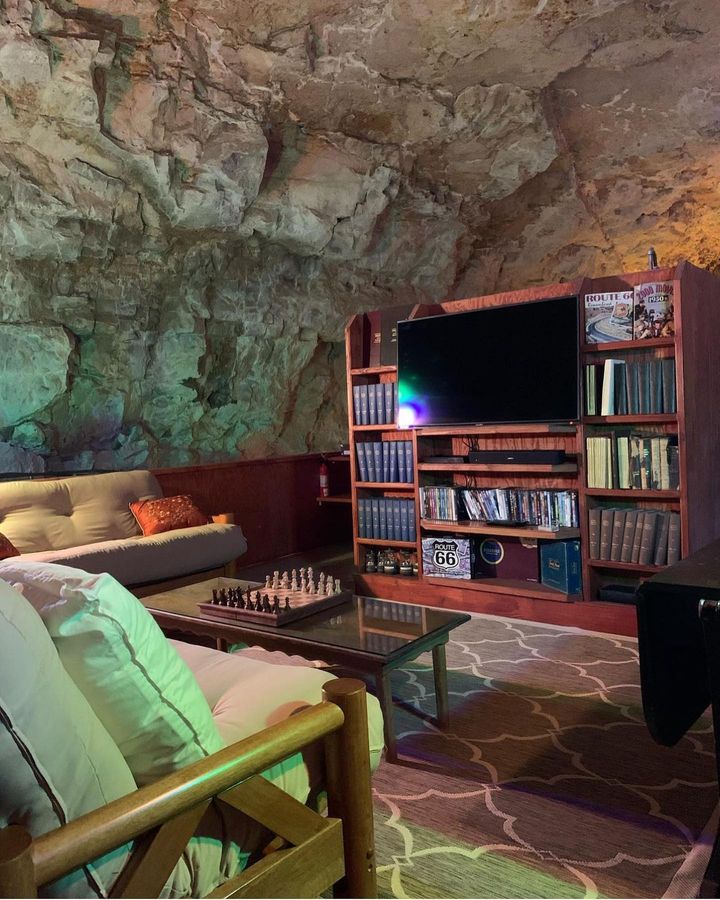
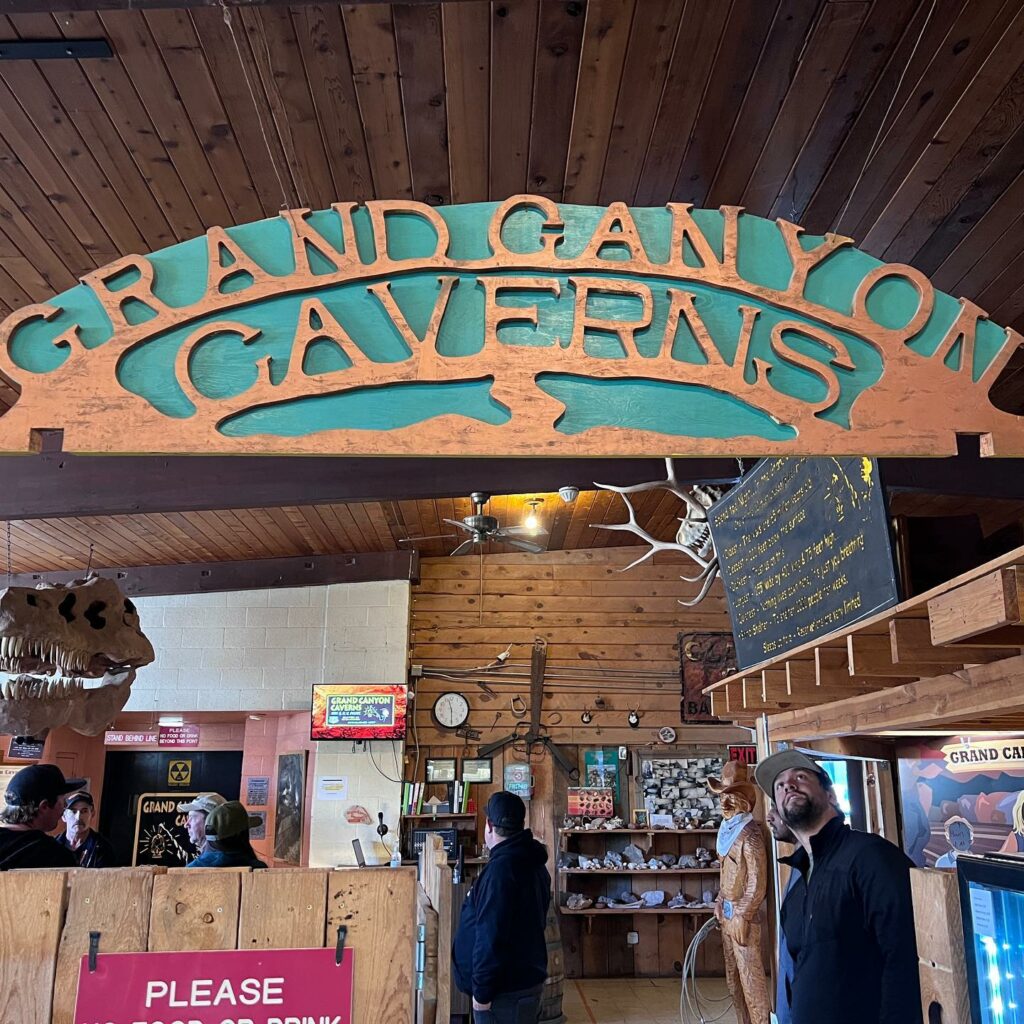
Located 200 to 300 feet below the surface, the Grand Canyon Caverns offer a refreshing change of scenery from the urban world. It’s one of the few unspoiled lands and among the largest dry caverns in the United States.
Within the cavern, you’ll discover hundreds of 3 million-year-old undersea fossils and prehistoric formations.
If you’ve got the time, you can spend the night at one of the cavern’s furniture suites with a functional RV-style bathroom, a kitchenette, a library of books, a refrigerator, a microwave, and even a TV.
Once back at the surface, you can visit the nearby restaurants or cocktail lounges, browse the gift shop, or explore the hiking trails.
Kingman
Located in the northwestern part of Arizona, Kingman, AKA The Heart of Historic Route 66, is a living tribute to the Mother Road.
In Kingman, you’ll find popular attractions like the Historic Route 66 Museum, the Kingman Railroad Museum, and the Desert Diamond Distillery.
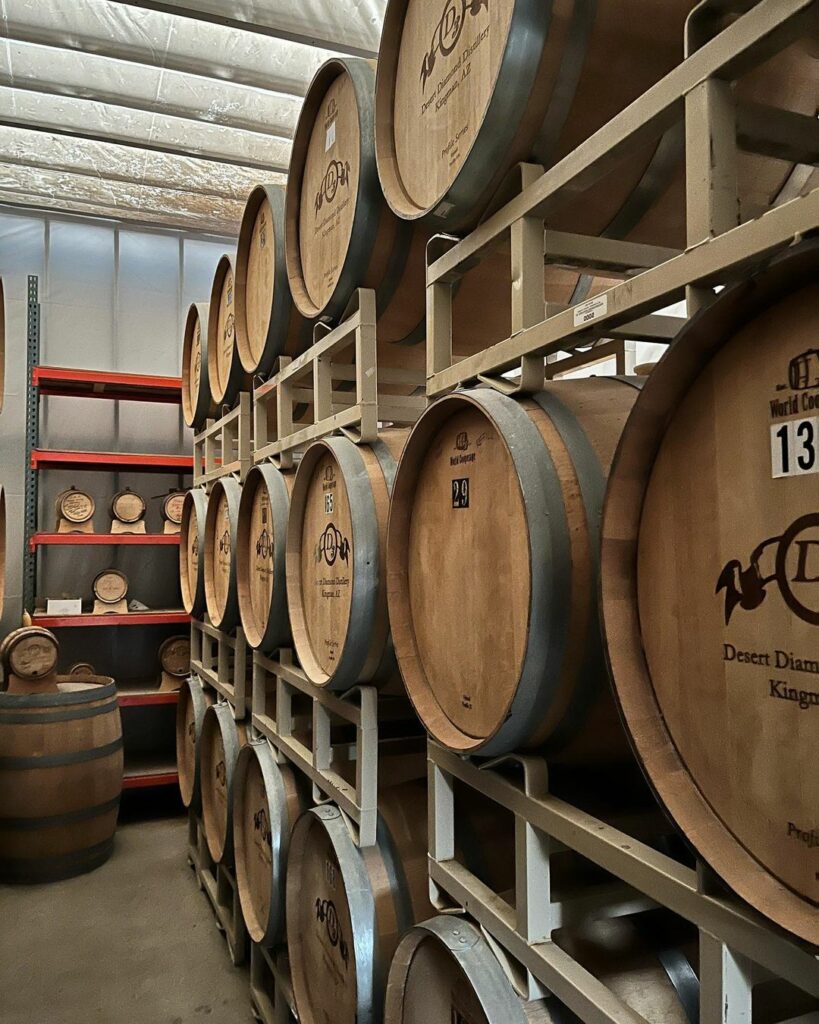
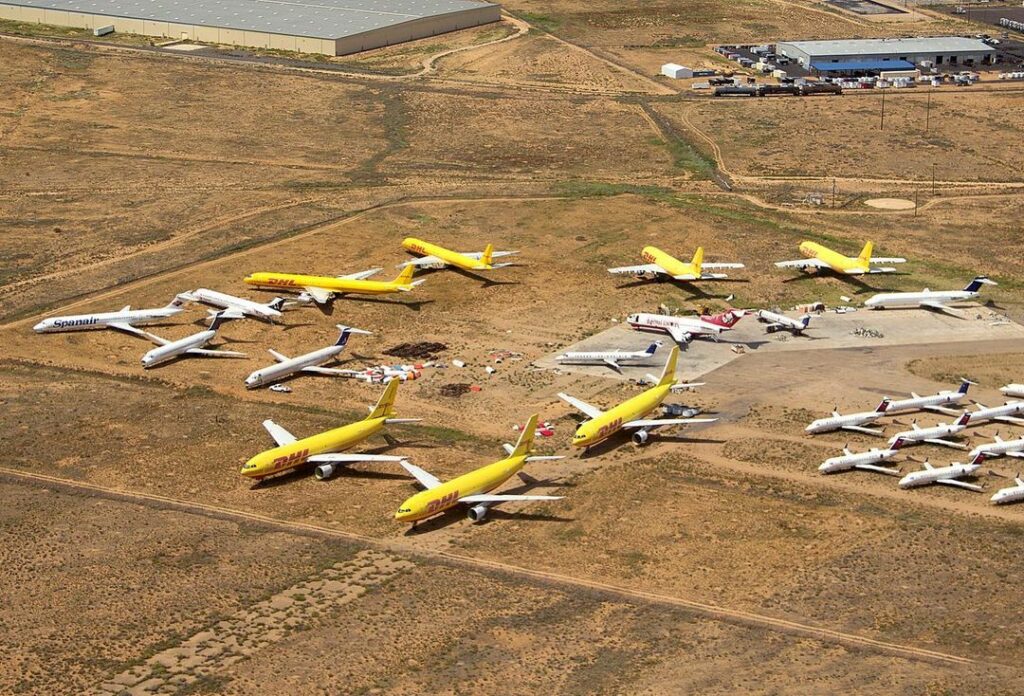
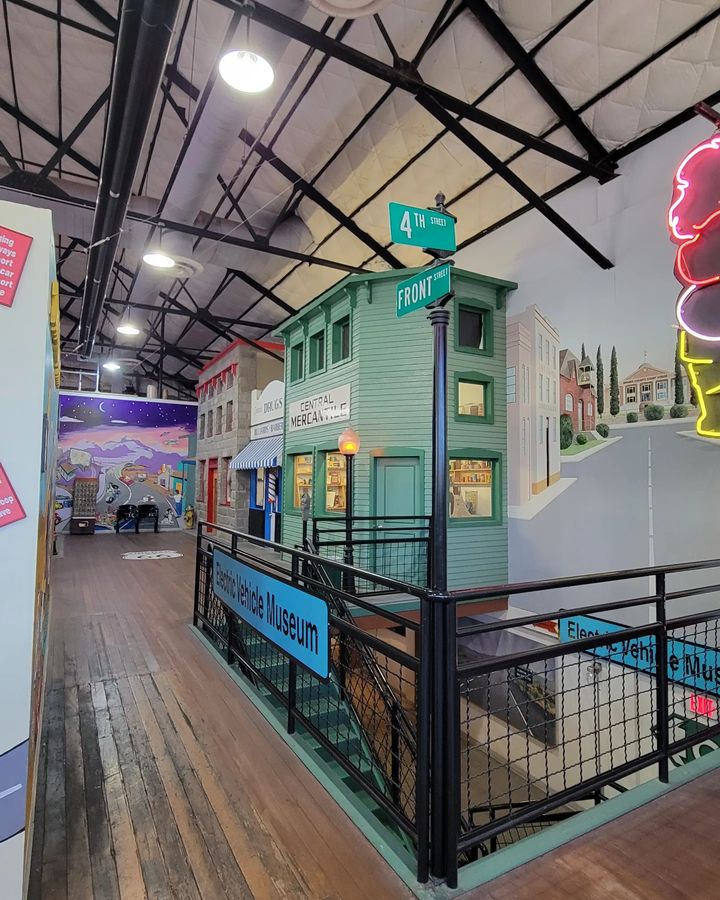
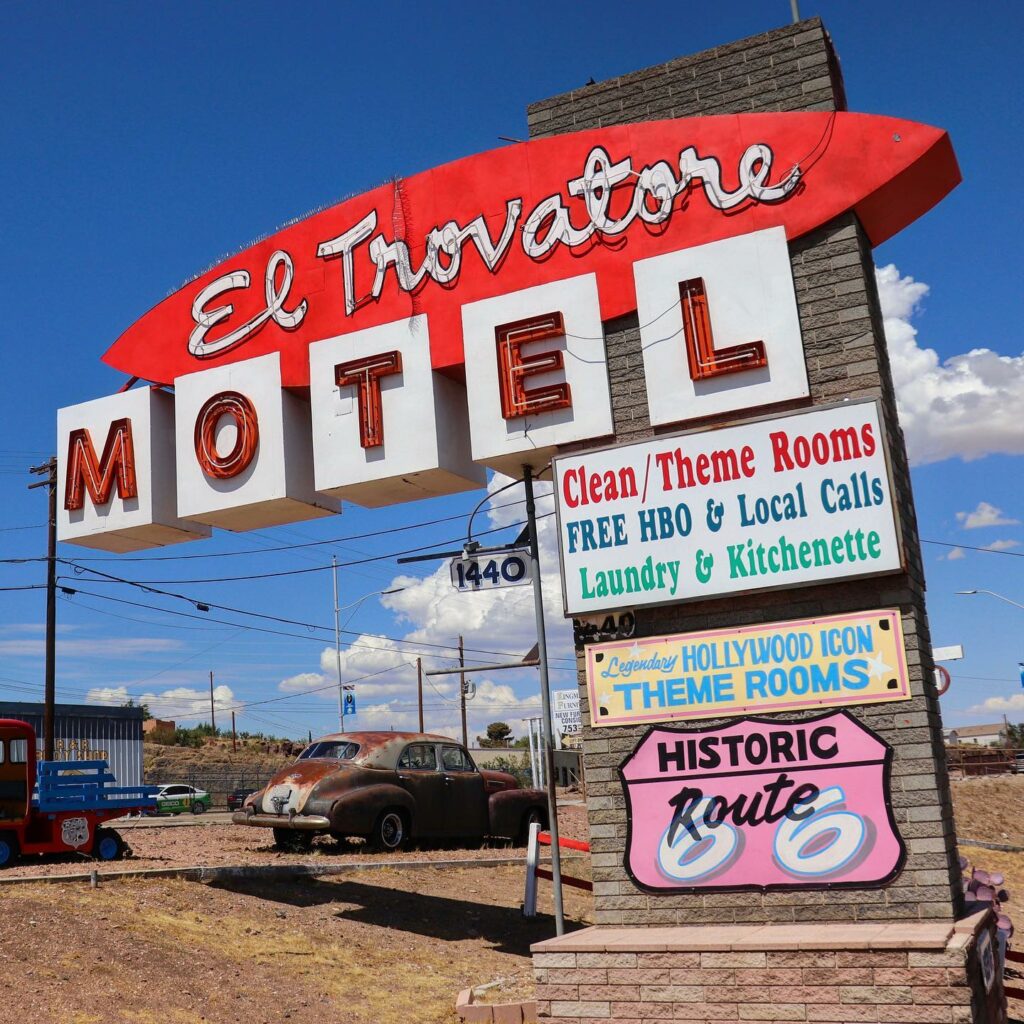
If you’re an aviation fan, be sure to stop at the Kingman Airport north of the town. It’s not only a storage facility for commercial airlines but also a major airplane boneyard.
Kingman has over 100 restaurants, cafes, and diners, and around 35 hotels and motels. The El Trovatore Motel is one of the few pre-World War II motels still in existence, and it showcases the “good old days” of the 1930s, 40s, and 50s.
Old Route 66: Oatman
Oatman is a mysterious town located between Kingman, Arizona, and Needles, California. It overlooks the Mojave Desert and is home to more donkeys than people. Dozens of these animals wander the streets of Oatman, nudging curious visitors for treats and head pats.
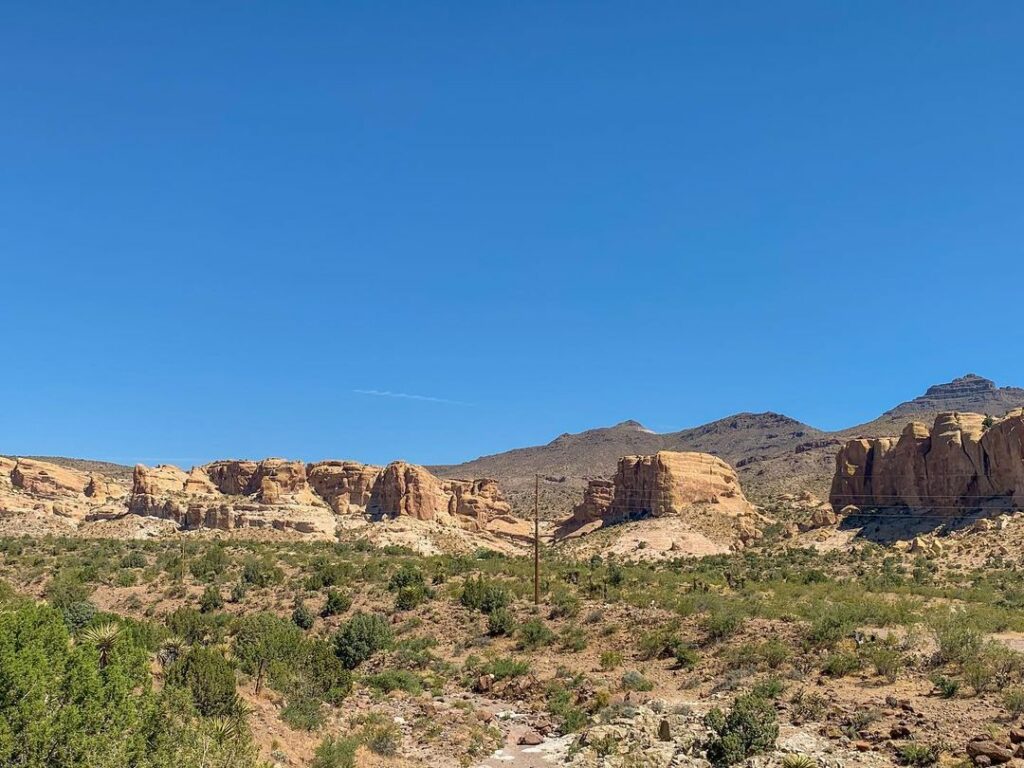
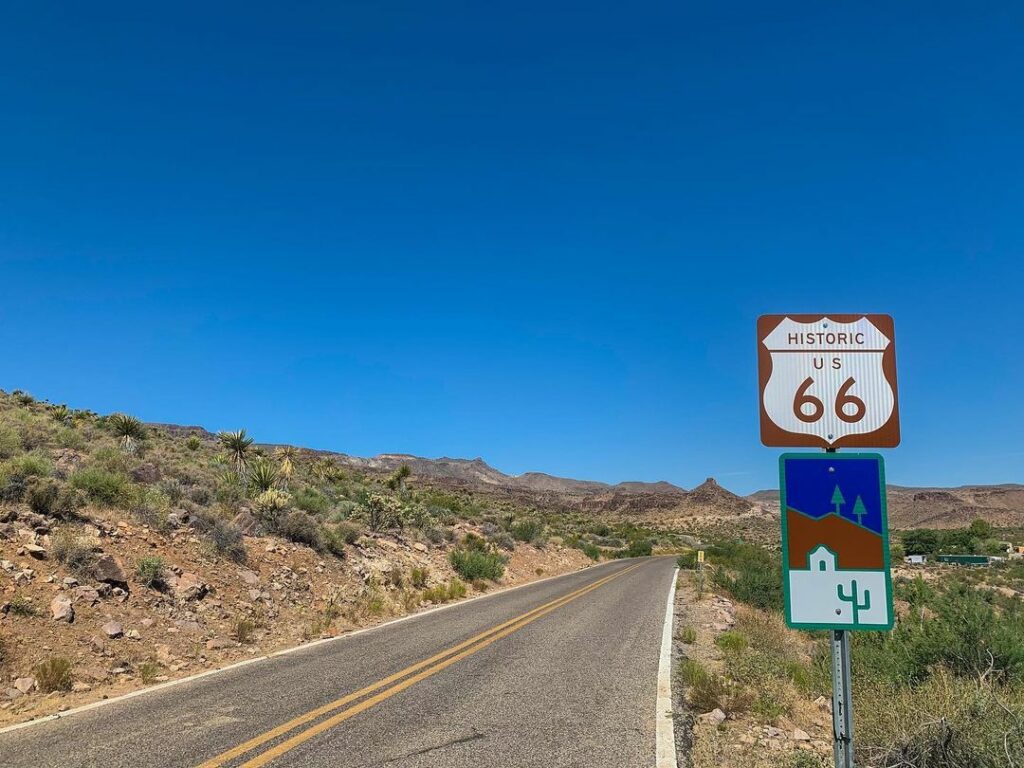
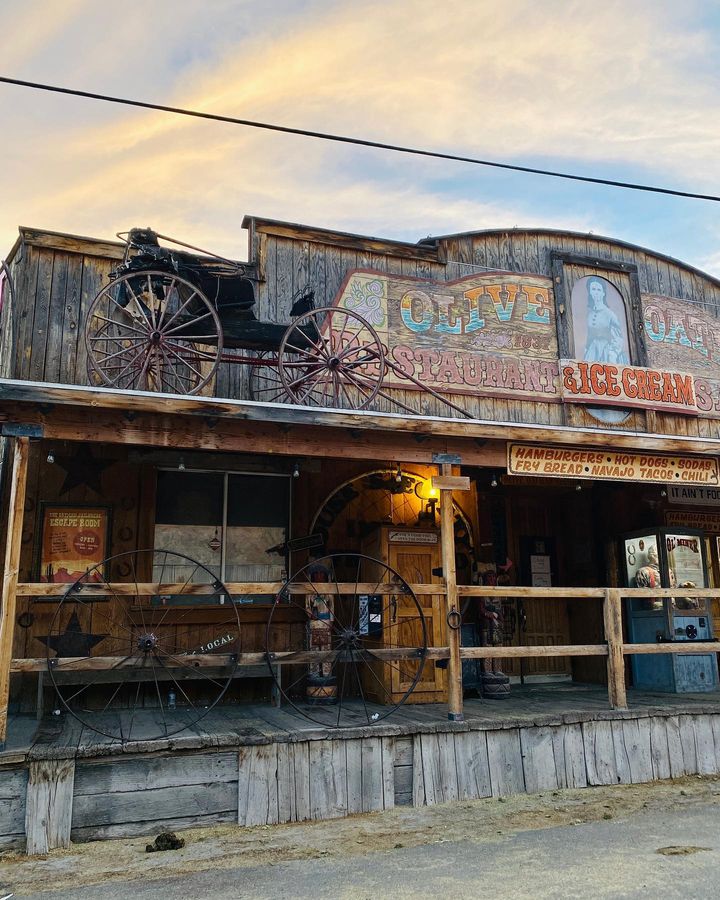
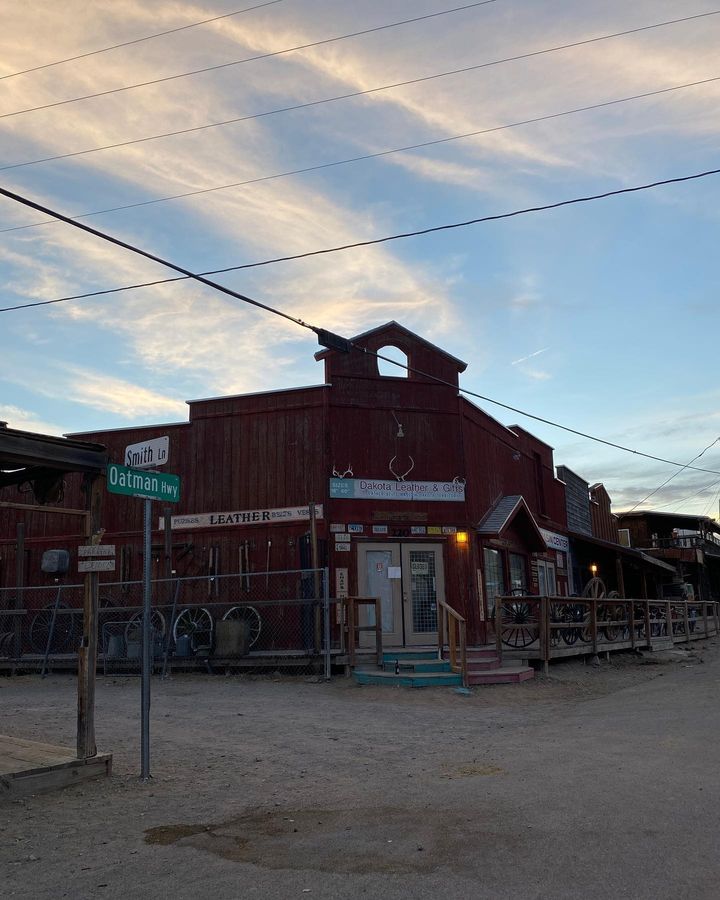
The people of Oatman treat the burros like family, so much so that they annually host a lighthearted competition of Burro Biscuit Toss. In the competition, residents and visitors compete to see who can throw a gold-painted burro dropping (yes, you read that right!) the farthest. The winner gets burro merchandise, a bar of soap, and a cash prize.
Where to stay along Route 66 in Arizona
You’ll find no shortage of places to stay along Route 66. Here are some of the most popular motels and hotels you’ll find, depending on the location:
- Holbrook: Brad’s Desert Inn, The Wigwam Motel
- Flagstaff: Super 8 by Wyndham Flagstaff, Little America Hotel
- Seligman: Deluxe Inn, Historic Route 66 Motel
- Williams: Grand Canyon Hotel, Red Garter Inn, The Lodge, Rodeway Inn & Suites Downtowner
- Kingman: Super 8 by Wyndham Kingman, El Trovatore Motel
- Winslow: La Posada Hotel & Gardens, Earl’s Route 66 Motor Court
Frequently Asked Questions
The Route 66 sign is scattered across Mother Road. You’ll find one in the parking lot of Kingman, in the street over from the Goldie’s Route 66 Diner in Williams, and on the main street corner of Winslow.
Route 66 is approximately 2,448 miles (3940 km) long.
Route 66 crosses eight states: Arizona, California, Texas, New Mexico, Kansas, Oklahoma, Missouri, and Illinois.
Route 66 is considered dangerous because it’s home to unpredictable weather conditions. Tornadoes, wildfires, and snow aren’t uncommon occurrences, so it’s best that you check the weather condition before embarking on a road trip to Route 66. Keep the local radio on as you travel so you’re always up to date with the weather news.
